Cardi B pays tribute to the style of ‘90s girl group TLC
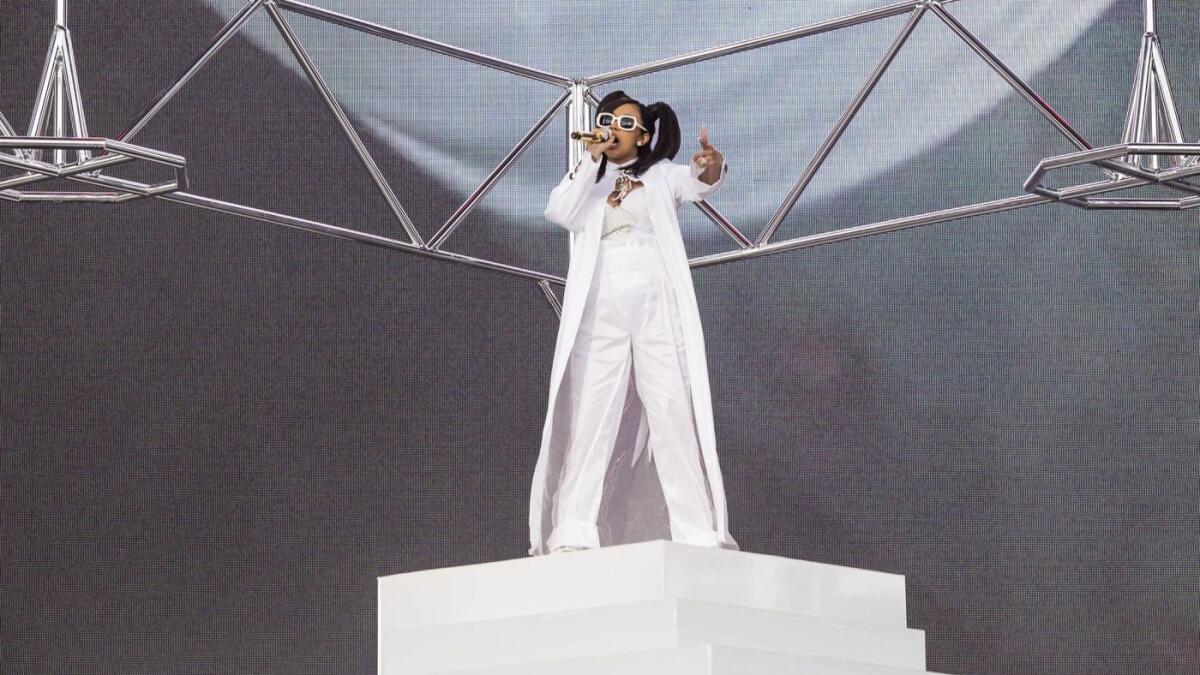
With a hit new record and her first child on the way, Bronx rapper Cardi B was every part the modern feminist as she hit the stage at the Coachella Valley Arts and Music Festival in Indio on Sunday night.
During an energetic performance, Cardi B, who is expecting with with her fiancé, Migos rapper Offset, didn’t let her pregnancy hold her back from her signature twerking moves to hits from her newly released album, the Billboard 200 chart-topping “Invasion of Privacy,” which has already shattered Apple Music’s record with more than 100 million streams.
The rapper and social media phenom was joined on stage by a crew of limber backup dancers as well as surprise guests including Kehlani, 21 Savage, YG, G-Eazy and Chance the Rapper.
Eminem plays it safe on closing night
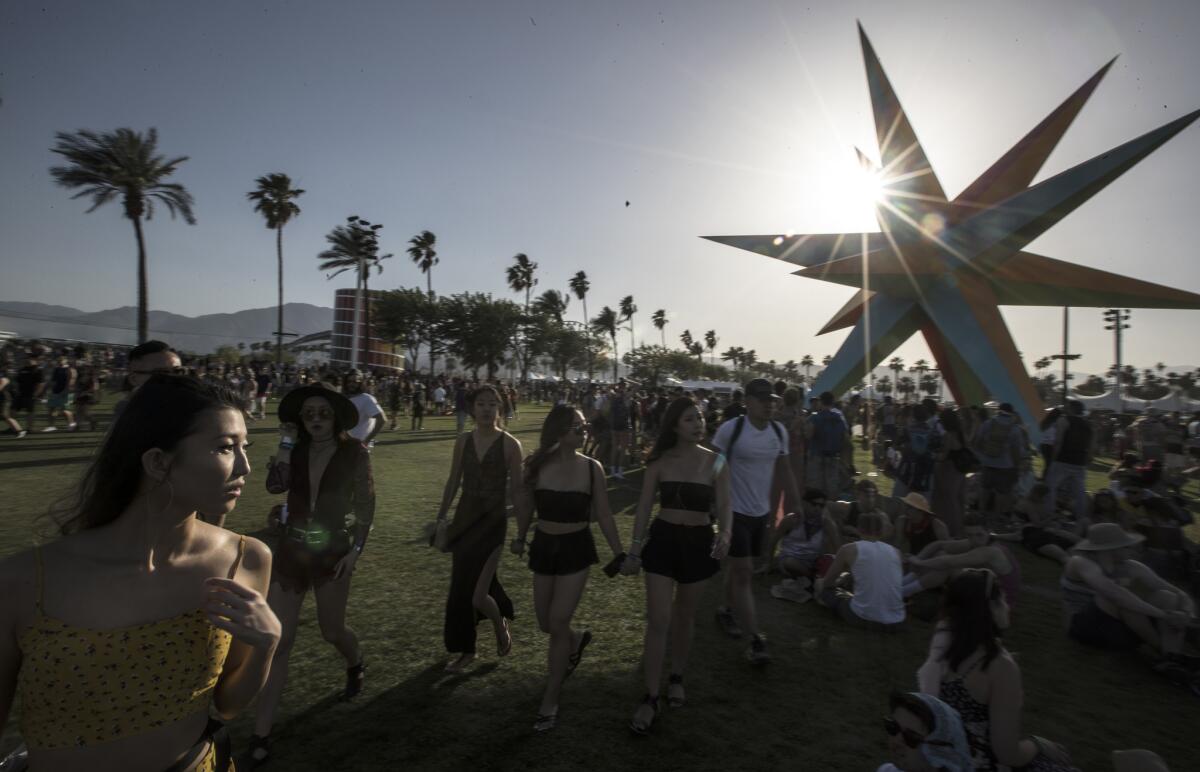
“How many of y’all remember this?” Eminem asked not long into his performance Sunday at the Coachella Valley Music and Arts Festival.
The rapper was introducing “Soldier,” a vintage cut about how tough he is from his 2002 album, “The Eminem Show.”
But he might have been quizzing folks more generally — unsure if Coachella’s young audience recognized his old-fashioned idea of hip-hop on a day when the festival’s other rap acts included the thoroughly modern likes of Migos (whose jumpy electronic rhythms put them in the Sahara tent) and Cardi B (who was celebrating the well-deserved No. 1 debut of an album she’d never had made if she hadn’t first found stardom on Instagram).
As has been mentioned many times, the once-rock-friendly Coachella turned largely away from guys with guitars this year, filling its most coveted slots instead with the MCs and R&B singers who dominate charts in the streaming era.
But where Friday’s and Saturday’s headliners — the Weeknd and Beyoncé, respectively — are as culturally relevant as they’ve ever been, Eminem on the event’s closing night represented something of a throwback: a dogged lyricist in an age defined by ad libs, a pop provocateur no longer able to shock, an angry white dude at a moment when Donald Trump has turned off many to just such a figure.
Where does Coachella go after Beyoncé?
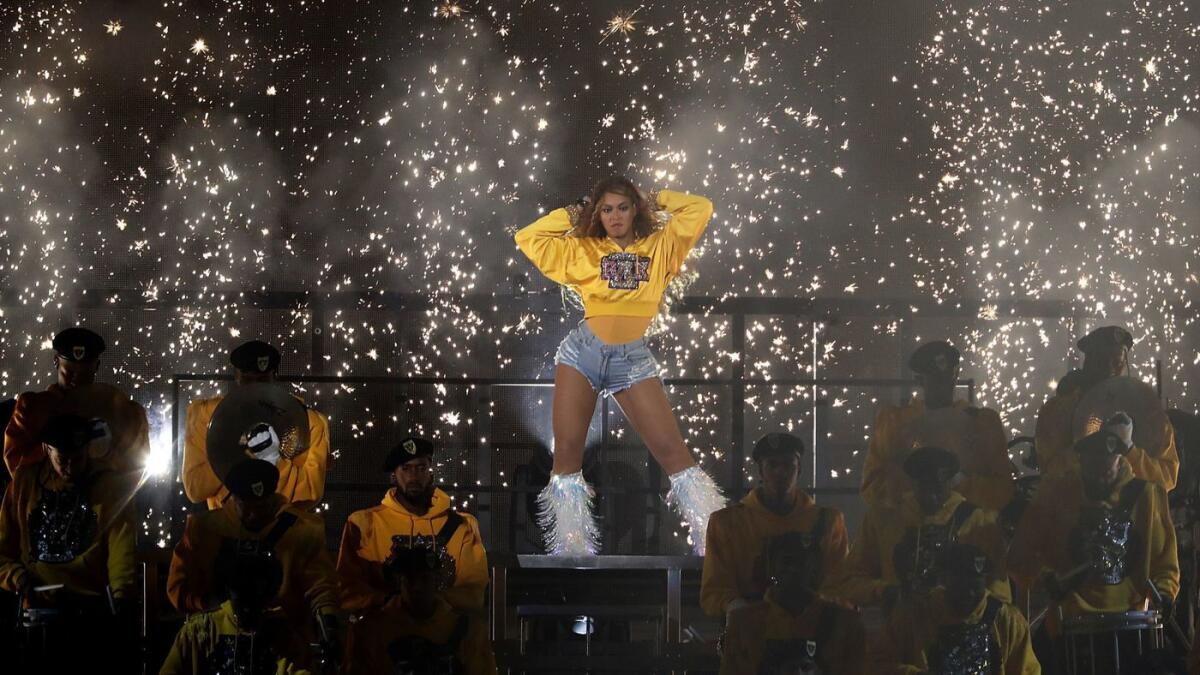
One thing’s for sure: Coachella will never be the same again after Beyoncé’s history-making, bar-raising, monumental achievement Saturday.
So given that fact, where does the show go from here?
There is exactly no one else working at her caliber of creative vision, execution and universal star power today.
Coachella will probably just have to accept that this was a lightning bolt from a better world. How can they work to support future headline acts who saw her show and felt that hot panic at being outclassed?
There are only a few Coachella-suited touring acts who can draw comparable crowds: U2, Metallica, the Rolling Stones, maybe Green Day on a good day. None of them are, to put it gently, working at the top of their game and appealing to the young, black vanguard that made this Coachella so different.
That’s where its future lies, and even if there’s no Beyoncé-level talent waiting in the wings (how could there be?), maybe the festival needs to make even more of an investment in cultivating it.
This year had more women in prime support slots (Sza, St. Vincent, Haim, Alison Wonderland) than any in recent memory, and while these acts need no introduction to fans, increasing diversity on the biggest stages will naturally yield a different vision of what a headline set can look like.
St. Vincent’s drippy minimalist videos, Sza’s campfire hangout motif and Haim’s ultra-closeup iconography of their faces each made powerful visual statements. No one can match Beyoncé’s physical prowess or budget for stage plotting, but at at least she’s started the conversation about how to elevate the experience.
Maybe more acts need to imagine Coachella not as the kickoff to a summer tour cycle, but as a show between records, one to plan for as a unique occasion. Beyoncé is due for a victory-lap tour with Jay-Z, and her cancellation last year due to pregnancy may have been a blessing for her live show, as it gave her an extra year to think, dream and plan this thing out.
That time and effort paid off. Maybe bands at that level need to imagine a headline less as promotion and more as a chance to reignite how the public sees them and their vision.
There are all sorts of things that get in the way of this — budgets, vision, scheduling, the existentially painful condition of Not Being Beyoncé.
But if you’re anyone capable of playing to 20,000 people a night, you had to walk away from that set feeling humbled and challenged. It’s likely time to take that feeling seriously, and for Coachella to support them any way they can.
At a show whose currency is built around the urgency of “being there,” that’s the moment you’ll come home to tell the world about.
Kamasi Washington and Portugal. The Man try to redefine pop
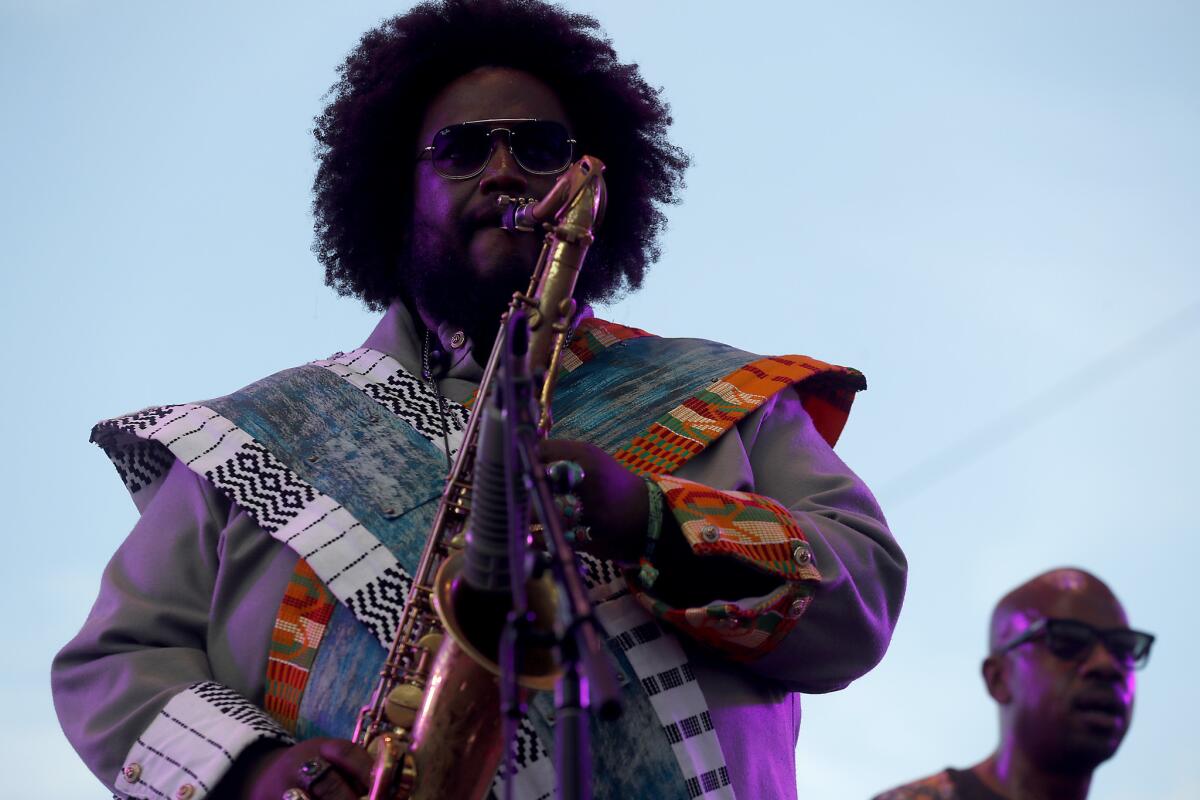
What does one do after a night like Saturday?
Never in Coachella history has anyone had to contend with a set like Beyoncé’s. On some level, she rendered all music before and after superfluous. She will be all everyone talks about and the thing everyone takes away from Coachella 2018.
But other acts made a sporting go of it, and tried to assert themselves into this history-making weekend for our headliner.
In the Yuma tent, Peggy Gou and Talaboman attempted to command the afternoon dance crowd with sets of hard-kicking techno that whipped the crowd back into shape after their mind-shattering night. The Yuma tent had a particularly stacked lineup Sunday (Omar-S, Motor City Drum Ensemble), and they all delivered accordingly. But the scale of the fest has been so thrown off, the standard set so high, that everyone was playing catch-up Sunday.
Portugal. The Man is a stalwart indie act who played a great hand of songwriting into a gigantic pop hit with “Feel It Still.” Their Main Stage set was, to be honest, largely playing catch-up to that radio staple — capable and career-spanning but maybe a bit outraced by their calling card. While they’ve been clearly preparing for this breakout for years (they sounded expert, even though to most they’re a new band), many wondered how they avoided a Foster the People-ish fate of scoring one huge pop hit while still trying to lock in their sound for a mainstream crowd. It worked here, but who knows what’s built to last anymore.
Well, here’s what is: Kamasi Washington. He is one of few acts that have the technical chops to contend on a post-Bey day. He has (another) sprawling multi-part album, “Heaven and Earth” coming out, and his free-jazz wanderlusting was exactly the look for the late afternoon. With a huge backing band of players that never let their virtuosity outshine the occasion, he wove his new material into cuts from his landmark “The Epic” with ease and grace and aspirations for transcendence. This is, obviously, a weekend for acknowledging black achievement and excellence in music; Washington is an L.A. treasure, and it’s so validating to see a mainstream crowd like Coachella both accept and embrace the challenge of his set as the landmark it was. Maybe Beyoncé was watching and needs a jazz band sometime soon?
Cardi B celebrates her No. 1 album with a packed Coachella gig
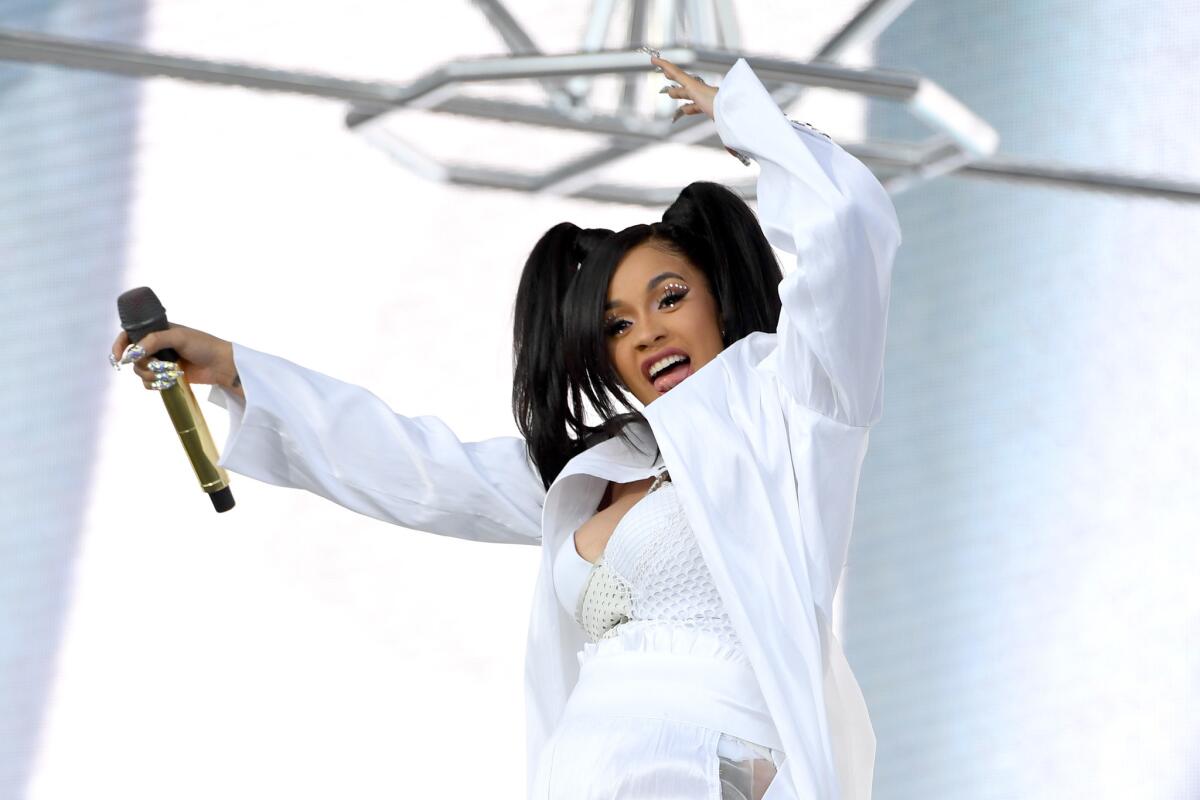
How to celebrate a brand new No. 1 album?
If you’re Cardi B — the Bronx-born rapper whose debut “Invasion of Privacy” just topped the Billboard 200 — you come to Coachella and perform for a crowd of maybe 50,000 people, as she did Sunday evening.
So how was the show?
Eh — not that great, to be honest. (Certainly not as great as the excellent “Invasion of Privacy.”)
Surrounded by a troupe of dancers dressed all in white, Cardi B was operating at what seemed like half-strength as she rushed through snippets of songs like “Bickenhead,” “Be Careful,” “I Like It” and, of course, her breakthrough hit, “Bodak Yellow.”
You could understand if she was tired, of course, given the non-stop promo campaign she’s been on since her album dropped this month.
And, really, there was no reason to be worried: Cardi B’s runaway success has virtually ensured that she’ll be with for us a long, long time.
She’s got plenty of time to up her live game.
Beyoncé came to Coachella, and disrupted its entire culture
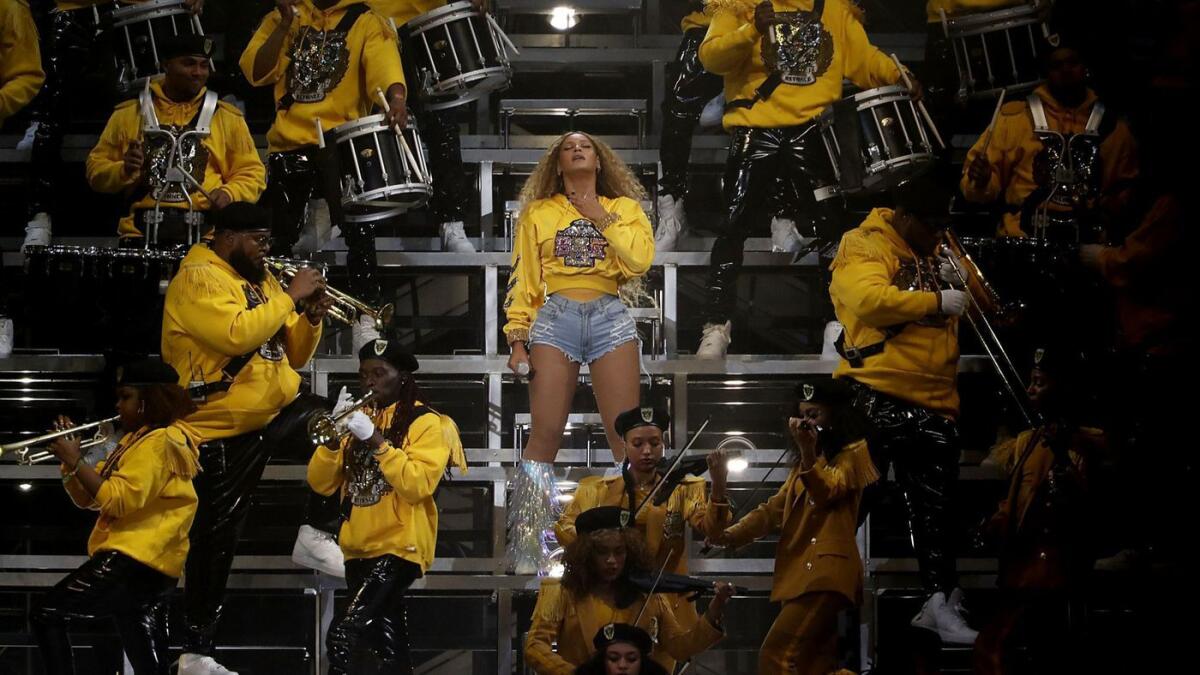
So much for the “white people stage.”
That’s how Vince Staples, the deeply skeptical Long Beach rapper, referred to the main stage of the Coachella Valley Music and Arts Festival as he found himself performing — with one eyebrow cocked in surprise — on just that platform Friday night.
And he was hardly being unfair: Since its founding in 1999, the annual multi-day event in Indio, which is widely regarded as the country’s most prestigious music festival, has generally privileged rock and dance-music acts such as Radiohead, Paul McCartney and Calvin Harris; in turn, the show has developed a loyal audience known, if somewhat less accurately, as a congregation of rich white kids.
Yet just over 24 hours after Staples’ pronouncement, Beyoncé replaced him in Coachella’s spotlight to deliver the most radical — and maybe the best — headlining performance I’ve ever seen here: a thrilling and painstaking tribute to America’s historically black colleges and universities that had the singer leading approximately 100 musicians and dancers, including brass and string players, a drum line, a baton twirler and even a lively step squad that went to work when she left the stage to change costumes.
Rock ‘n’ roll may be pushed aside, but it isn’t dead yet
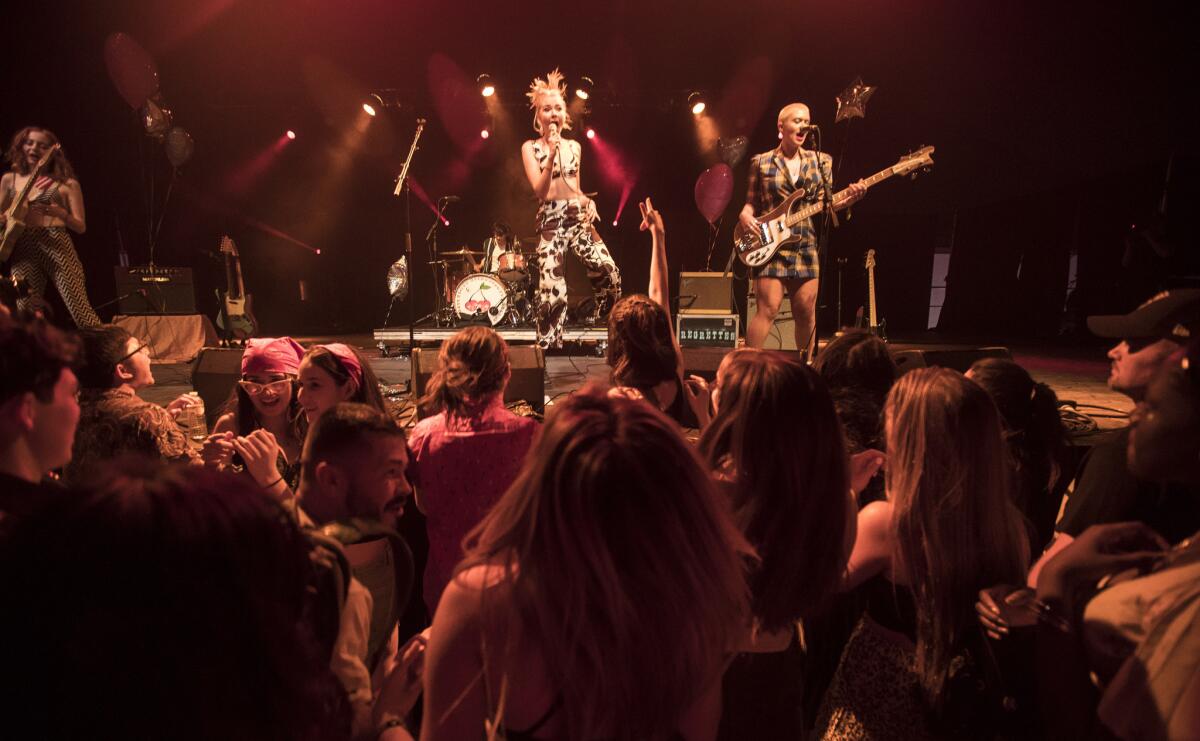
While there weren’t many guitars on Coachella’s mainstage, plenty were tucked away into the club-like atmosphere that is of the Sonora tent. But rock fans shouldn’t be bummed about being pushed aside to an out-of-the-way dome: The place, at least, is air-conditioned, making it one of Coachella’s best not-so-hidden gems.
On Friday, the Regrettes delivered a spirited set of ’60s-tinged pop with a punk rock edge. With band members ranging in age from 17 to 21, the local act makes the case that today’s young’uns haven’t completely abandoned the sounds of yore, all while putting a topical bent on songs that celebrate weirdness and individuality while tackling topics such as sexism and cultural divisiveness with a snarl.
The following day, Priests put even more anger into their songs, which could veer from the good-time vibe of surf rock to scrappy, stuttering anthems aimed at confronting the listener.
Yet whether opting for chaos or suddenly slipping into a tightly wound melody, the Washington, D.C., band follows the seemingly unpredictable whims of vocalist Katie Alice Greer, whose songs are ready to pick a fight with capitalism, the White House or even those who just endlessly pontificate.
Priests can immediately attract attention because Greer can sing with the best of ’em, but then her out-of-nowhere howls or rapid-fire sing-speak approach will take the songs down another, more jarring path — one that reflects the sound of opposition.
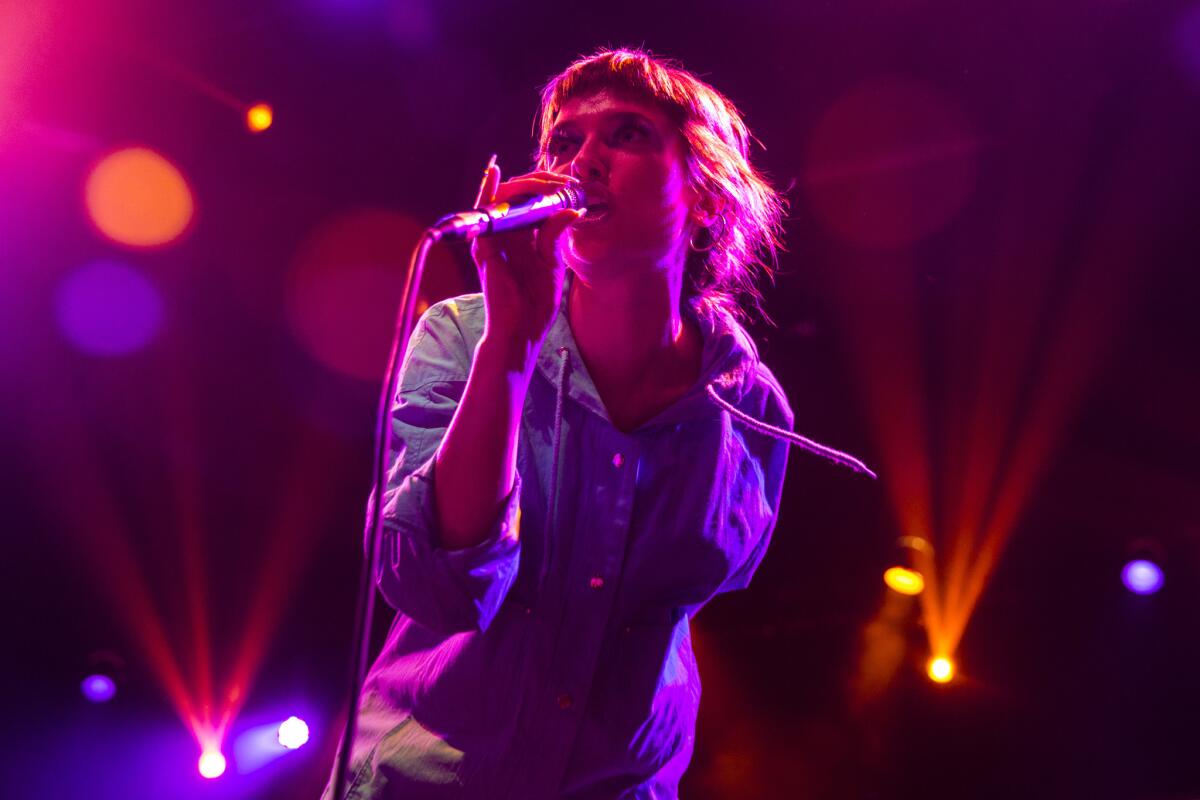
Don’t overlook Jamiroquai’s Coachella comeback
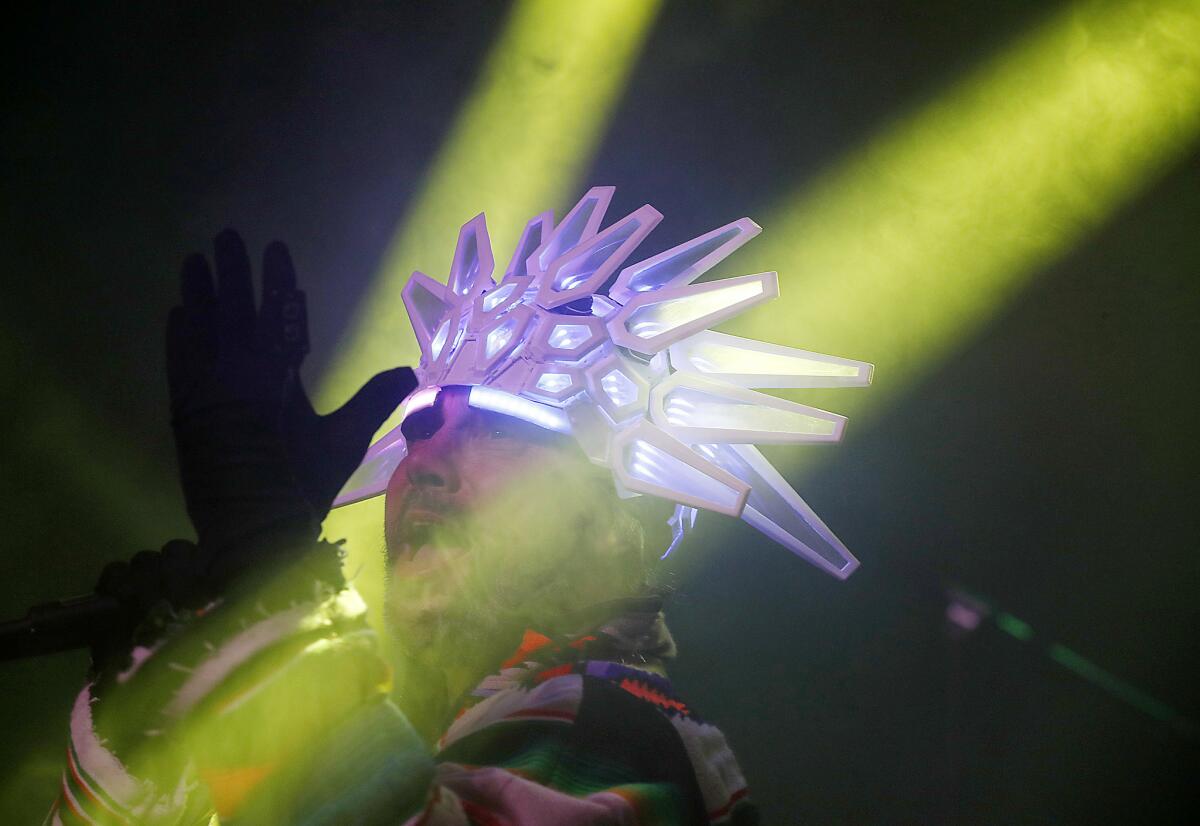
Beyoncé wasn’t the only comeback story of Coachella as the weekend also played host to the return of Jamiroquai.
The British electro-funk collective, which rose to prominence in the mid-’90s, played its first concert in America since 2005 late Friday night.
Jamiroquai’s heady approach to funk lured a massive crowd of bodies that spilled out of the Mojave tent — a feat made most impressive as the band was programmed against the Weeknd, one of the festival’s mega-draws this year. The band delivered a spirited set that kept fans dancing into the early morning, long after the mainstage crowd had exited.
The band was even joined by Snoop Dogg for a take of “Gin and Juice.” “It’s nice to be back in America,” frontman Jay Kay told the crowd. “Sorry it took so long.”
A post-Beyoncé lazy Sunday at Coachella? Not entirely
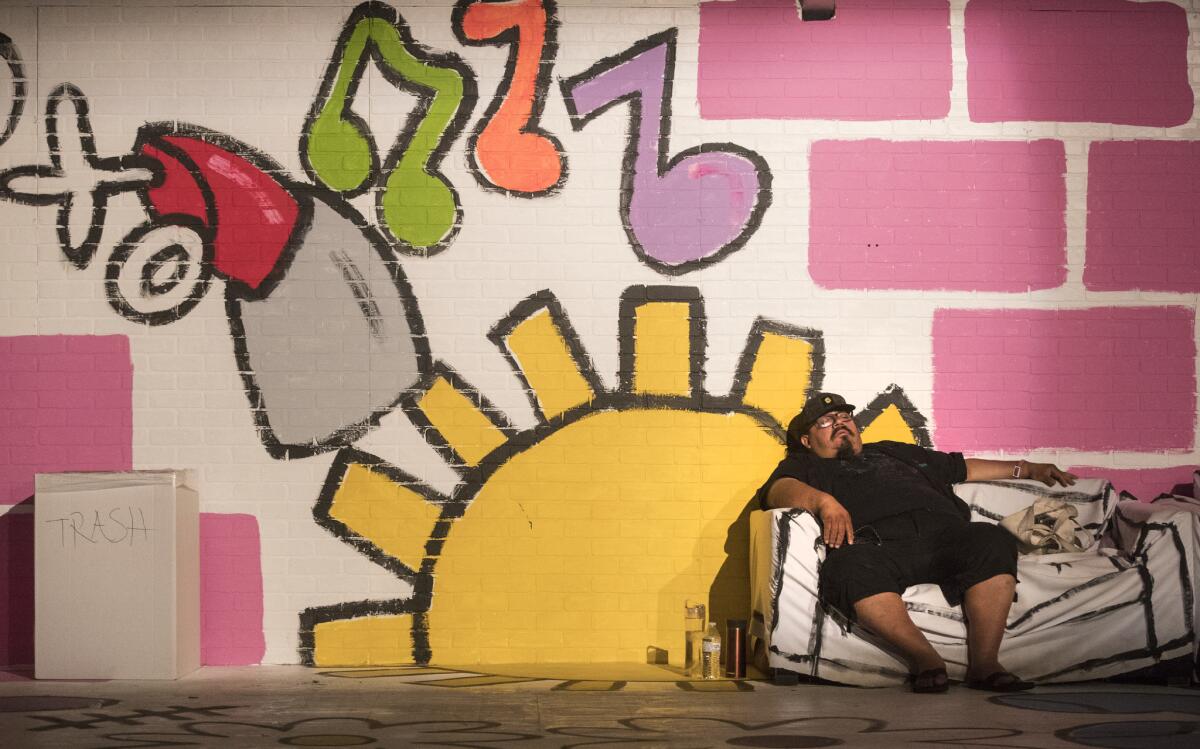
Historically, Sunday afternoons are the most relaxed at Coachella as festival-goers tend to slow down after two full days of musical wanderlust, and this year was no different.
With a vast majority of passholders either lounging pool side or snarled in traffic getting in, the grounds were wide open as the afternoon wound down.
The extra leg room made it easy to really take in the widened landscape, traversing all of it made easy by the day having the coolest temperature of the weekend.
That’s not to say things were dead Sunday afternoon.
LANY’s dreamy synth-pop was a major mainstage draw, with a lot of the audience stretching out on the field to take in the set. Meanwhile, fans spilled out of the Mojave for Amine’s energetic offering of charismatic raps.
Beyoncé hired alumni from historically black colleges to help her get in ‘Formation’
Yes, we are still trying to recover from Beyoncé’s deliriously over-the-top showing at her historic Coachella set on Saturday night.
There’s lots to unpack, and more time (and another viewing) is required, but one thing folks are still gobsmacked over is the sheer scale of the production, made possible with nearly 100 dancers and band members who helped the pop star bring her homecoming to life.
For those who didn’t watch — or did catch the show, but didn’t get it — Bey framed her comeback performance as if it was the half-time show during homecoming, more specifically one set at a historically black college or university where the annual celebration is somewhat of a religious experience.
Of course there was the muscular choreography she’s revered for, which stayed on theme by incorporating stepping and J-Setting — movement born out of black college life — and Beyoncé even created her own sorority, Beta Delta Kappa.
But at the core of her exhilarating performance was the marching band, which, like the rest of her set, was true to detail.
The singer tapped members of DRUMLine Live to back her for the performance.
DRUMLine Live is an international tour based on the marching band tradition from HBCUs and has alumni from Florida A&M University, Tennessee State University, Alabama State University, Prairie View A&M University, Hampton University, North Carolina A&T State University, Norfolk State University, Bethune-Cookman University, University of Georgia, Kennesaw State University and more.
Beyoncé goes with Balmain looks for Coachella performance
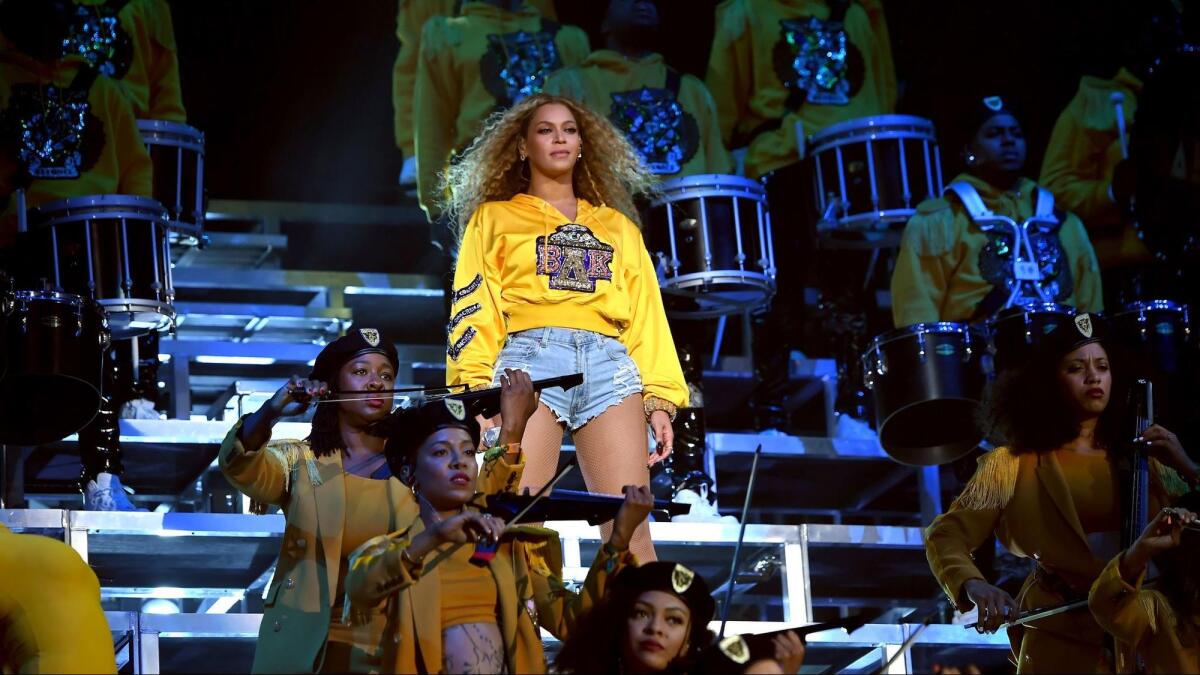
A year after Beyoncé was originally set to take the stage at Coachella Valley Music and Arts Festival in Indio, Calif., the pop star finally made history Saturday night as the first black female to headline the event.
During a more than two-hour-long set that closed out the night on the festival’s main stage, Queen Bey delivered an electrifying performance of her greatest hits, backed by a hundred singers and dancers, and a drumline. The show also featured surprise appearances by her husband, Jay-Z, sister Solange, and a 20th anniversary reunion with her former Destiny’s Child group mates, Kelly Rowland and Michelle Williams.
Topping it all off were five dazzling outfit changes featuring custom looks by Balmain creative director Olivier Rousteing created in collaboration with Beyoncé’s stylist, Marni Senafonte, and the singer herself. Rousteing also designed the looks worn by the backup dancers and musicians.
Artists and fans complain that, like the weather, Coachella crowds have been a record dry
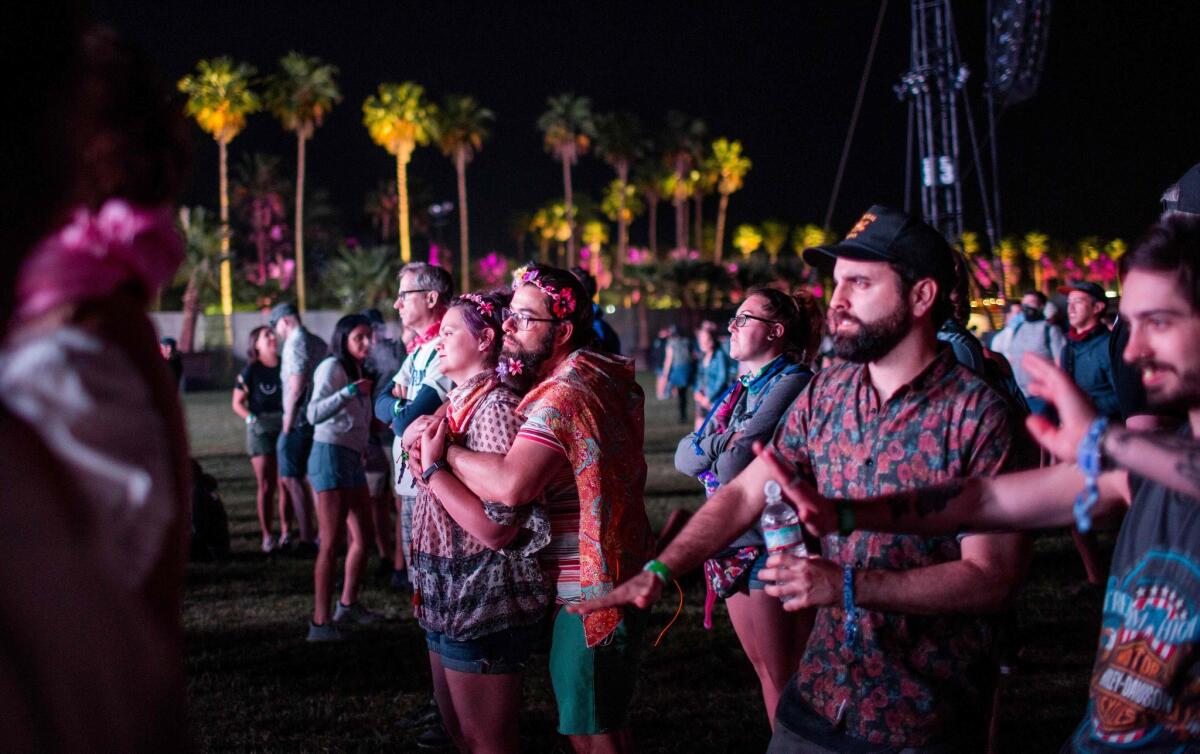
Some artists and social media observers thought the crowd at this year’s Coachella Valley Music and Arts Festival appeared as dry as the climate.
“This is dry,” said Tyler, the Creator during his set on Saturday night. “I haven’t had a set like this since 2011. The fall-off is real.”
As artists like SZA, The Weeknd and Vince Staples took the stage at the premiere music festival — one that had its roots in underground rock but has expanded to EDM, hip-hop and R&B in recent years — their fans took to Twitter to lament about how lackluster their fellow festival-goers appeared.
But did they have a point, or was this just a case of fear of missing out? Or, perhaps more likely, dancing wildly in 90 degree heat for 8 or more hours just isn’t possible without a trip to the medical tent for rehydration.
Even Beyoncé’s set wasn’t met with the energy many thought her incredible two-hour performance deserved.
Although, it should be noted, that if you were actually in the crowd, you were packed in tight, and it was downright near impossible do anything than stand in place — such was her drawing power.
The review: Beyoncé proves she was worth the wait
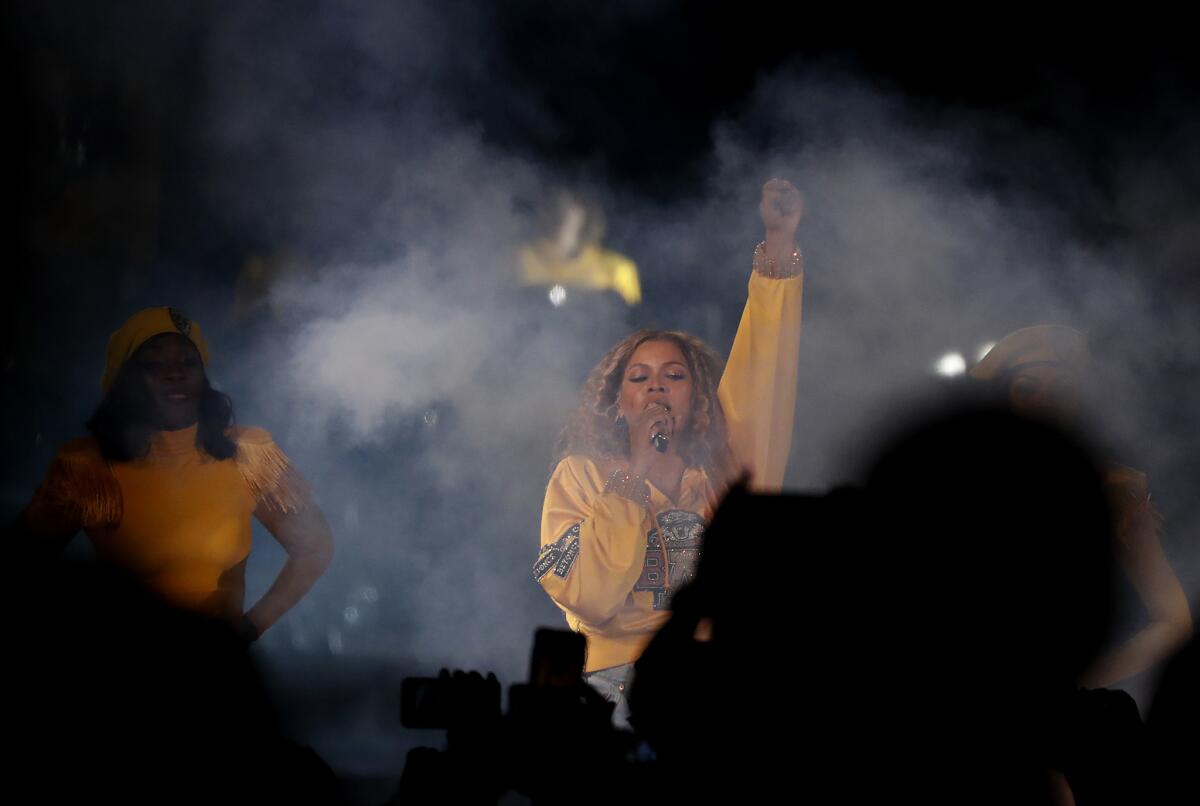
Look, there’s really no other way to say it: Beyoncé’s headlining performance Saturday night at the Coachella Valley Music and Arts Festival was one of the most impressive things I’ve seen in 20 years of professional show-going.
The scale, the reach, the detail — and the feeling — simply put it on a level higher than those on which most other artists operate.
And Beyoncé knew it.
“I was supposed to perform at Coachella before,” she said with a grin near the end of show, referring to the 2017 edition of the annual mega-festival at Indio’s Empire Polo Club. “But I ended up pregnant.” That allowed her the time, continued the mother of 10-month-old twins, “to dream” up something big “with two souls in my belly.”
Did she really spend a year planning Saturday’s concert?
Probably not.
But then again…
Described in a booming introductory voiceover as “Beyoncé Homecoming 2018,” the gig served as a warm and vivid tribute to America’s historically black colleges and universities, a concept she was clearly tying to her role — as she happily pointed out onstage — as the first black woman to headline Coachella. (“Ain’t that ‘bout a bitch,” she added in a pitch-perfect aside.)
She was accompanied by approximately 100 dancers and musicians, including brass and string players, a drum line and a baton twirler; at several points, Beyoncé disappeared to change costumes and was replaced in the spotlight by a lively step squad.
Beychella report: What Beyoncé fans are saying about her Coachella performance
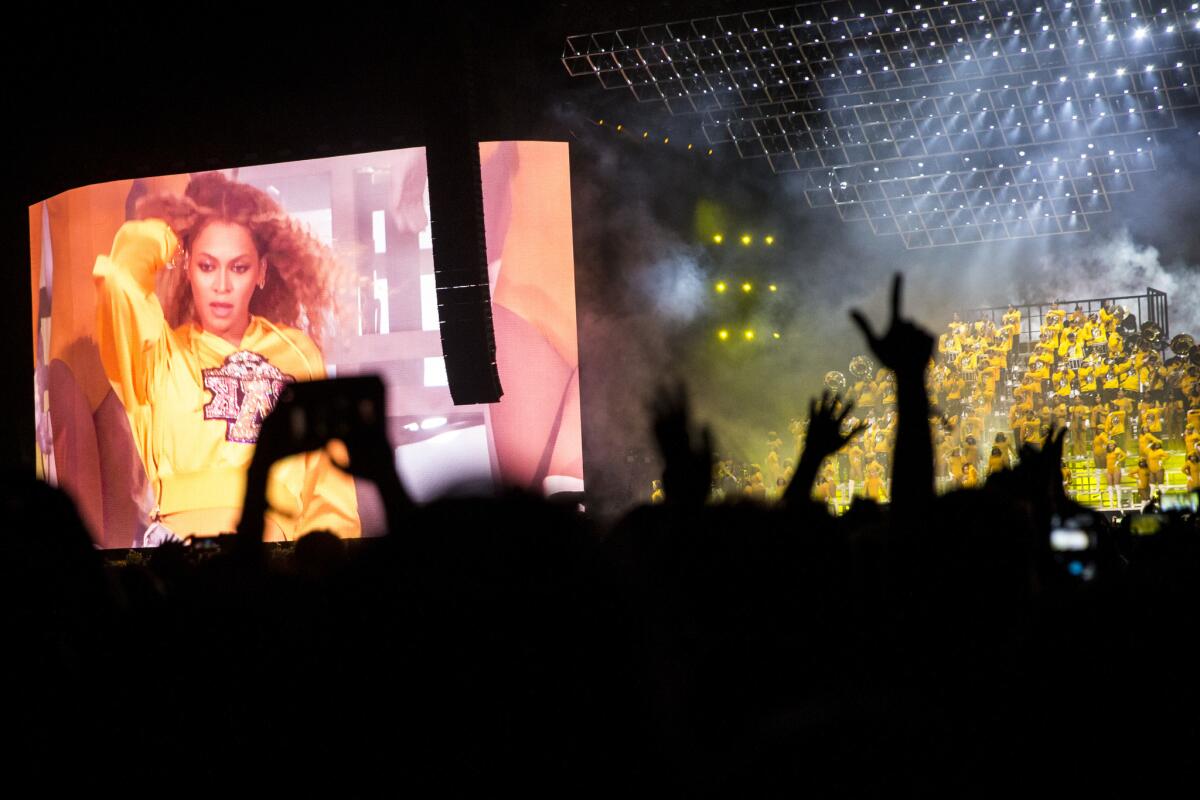
Whether they were in the audience at the Coachella Valley Music and Arts Festival or watching the livestream, Beyoncé fans were glued to her Saturday-night performance. They liked what they saw, from her halftime-show-style opening with legions of dancers to the special-guest moments with husband, Jay-Z; sister, Solange Knowles; and especially Kelly Rowland and Michelle Williams, who joined Queen Bey for a long-anticipated Destiny’s Child reunion, even if it only lasted for a few songs.
Check out Beyoncé’s full Coachella set list
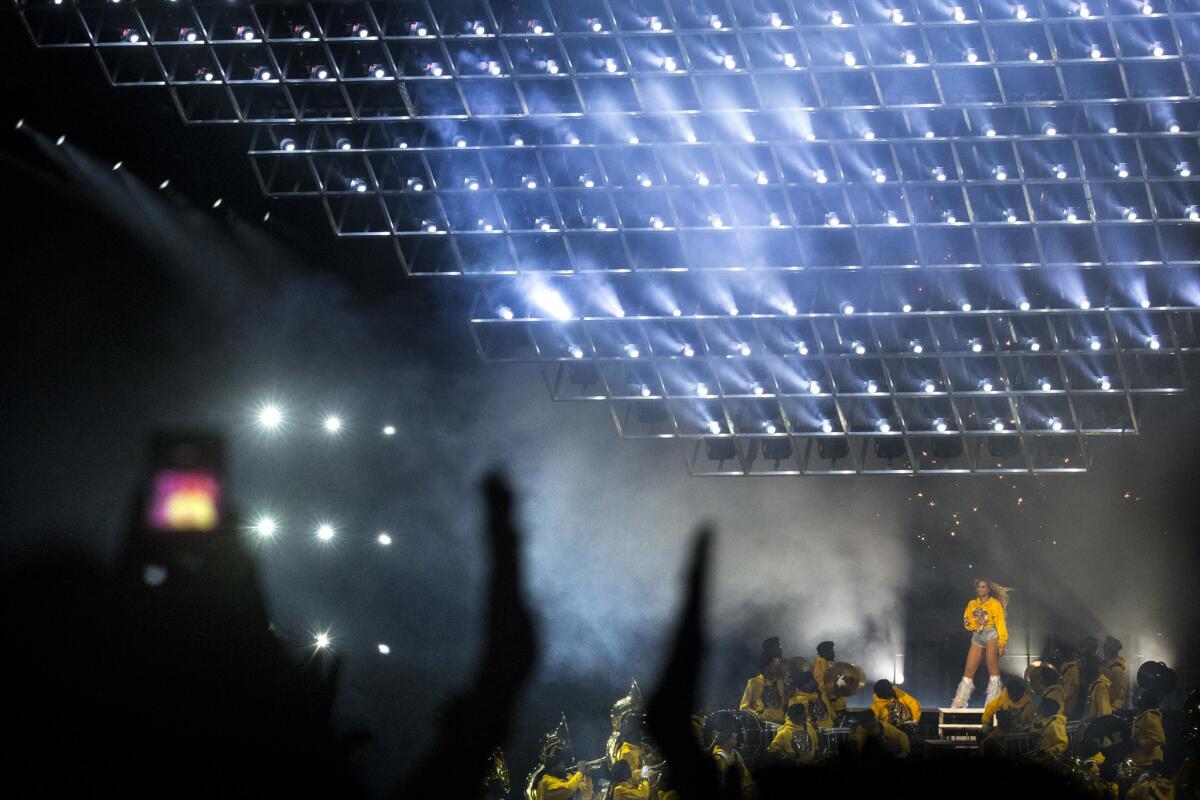
Fifteen months after Beyoncé was first unveiled as a headliner, the superstar finally took the Coachella stage Saturday night. Beyoncé not only made history as the first woman of color to headline the festival solo, but her performance even inspired a new name for the nearly 20-year-old event: #BeyChella. Just like her guest list for the evening, which included her husband, Jay-Z; her sister, Solange; and her former Destiny’s Child bandmates, Kelly Rowland and Michelle Williams, her set list was equally eclectic, spanning from recent hits like “Mi Gente” to Destiny’s Child throwbacks like “Say My Name.”
Check out her entire set list below:
“Crazy In Love”
“Freedom”
“Lift Every Voice and Sing”
“Formation”
“Sorry”
“Bow Down”
“Drunk In Love”
“Diva”
“Flawless”
“7/11”
“Don’t Hurt Yourself”
“I Care”
“Partition”
“Yoncé”
“Mi Gente”
“Baby Boy”
“Hold Up”
“Countdown”
“Check On It”
“Déjà Vu” featuring Jay-Z
“Run The World (Girls)”
“Lose My Breath” with Destiny’s Child
“Say My Name” with Destiny’s Child
“Soldier” with Destiny’s Child
“Get Me Bodied”
“Single Ladies (Put A Ring On It)”
“Love On Top”
Coachella is now measured in B.C. and A.C. (Before Mrs. Carter, and After)
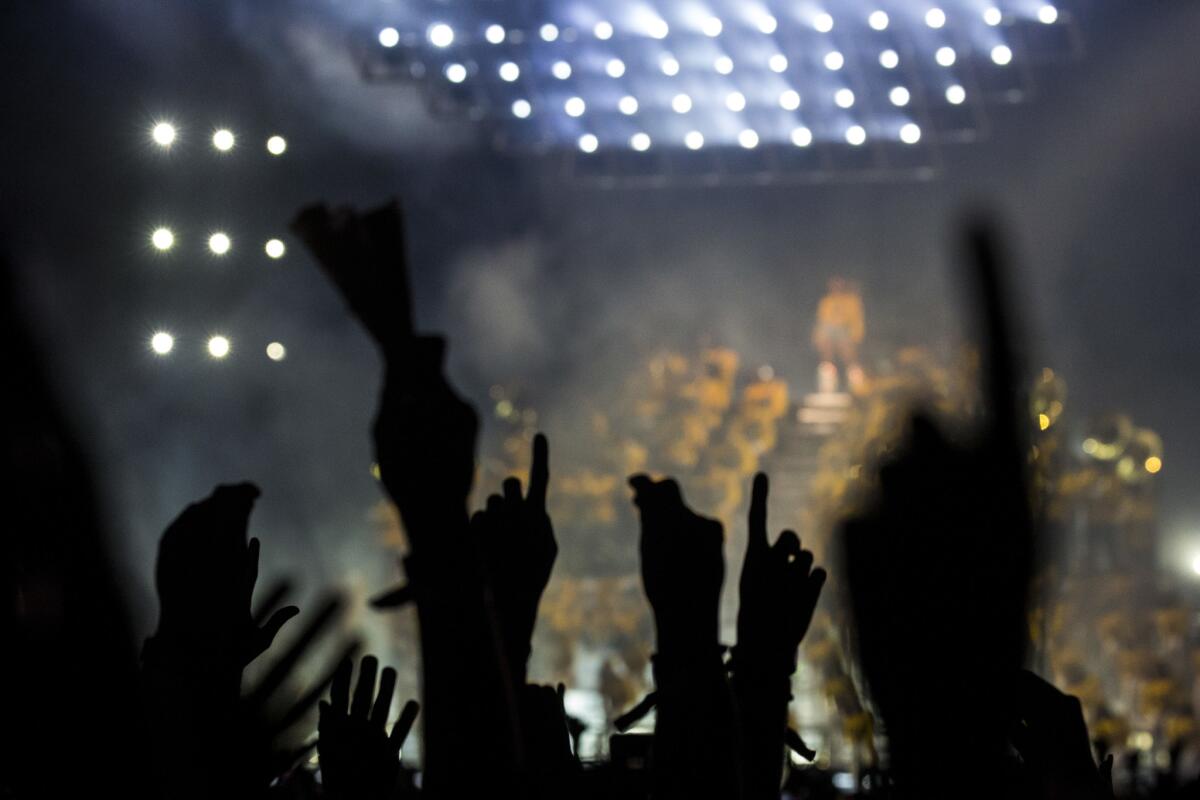
Coachella can no longer be measured in days, weekends or years. It may now only be referred to in two epochs: B.C. (Before Mrs. Carter) and A.C. (After Mrs. Carter).
The L.A. Times will have much longer thoughts from critics who are still putting their heads back on after Bey’s two-hour detonation of the festival set format.
But for now, let’s take a distant glimpse back into the B.C. World, one where we did not yet know the way, the truth and the light to come.
The DJ the Black Madonna, activist and advocate for women in music, would have been the first to corral her fans out to the main stage to see history like this. But in the hours before, she played one of the strongest dance music sets of the show, starting much more aggressively than her recent disco output might have suggested — bare-knuckle house with techno accessories, sometimes with a wink at the scene with a Cardi B. Lyric spliced in for some zip.
“This is my first time seeing her and I probably would have just stayed in the Yuma Tent,” one fan was overheard saying about Black Madonna’s set. “Everybody was telling me to go to this.” But alas, royalty called outside.
Earlier, Brockhampton filled out the Mojave to the brim. It turned out to be one of the day’s most ravenously anticipated shows, for good reason: with a new RCA deal under their belt and a fresh wind of new material behind them, their rowdy, genial and extremely well-crafted music from the wilds of the internet took on a life of its own in the flesh. They semi-winkingly call themselves a boy band, and could well hit that kind of ubiquity while staying true weirdos, and that’s no small feat.
Back in Sahara, Blackbear had one of the biggest turnouts for the mega-popular brand of sad, psychedelic hip-hop tinged with pop and R&B. Online, he gives off kind of a less-volatile Lil Peep vibe, but in person it turns out he has a truly impressive singing voice, with precise delivery that adds soulful touches to his tales from the dark side. He had a lot of fans going in, but he probably made a few more by thoroughly beating expectations.
And in a last-dash effort to get songs in before the reign of Bey, the Canadian group Alvvays has grown from a winsome indie band into a prime-time festival act. Their dreamy, sad-eyed pop on “Antisocialite” turned out to have plenty of muscle underneath, and singer Molly Rankin has mastered her high, lonely voice in a way to carry the crown.
Poor X Japan, the arena rock superstars who had to carry the opposite- Beyoncé slot. The crowds couldn’t have been what a band of their stature expected to deserve for a Coachella late-night appearance, but someone had to draw the short straw. Maybe someday the benevolent Coachella monarch Beyoncé (the fest is called “Beychella” now, per instructions) will find a way to make it up to them.
Beyoncé takes the Coachella stage, and brings Destiny’s Child and Jay-Z along for the ride
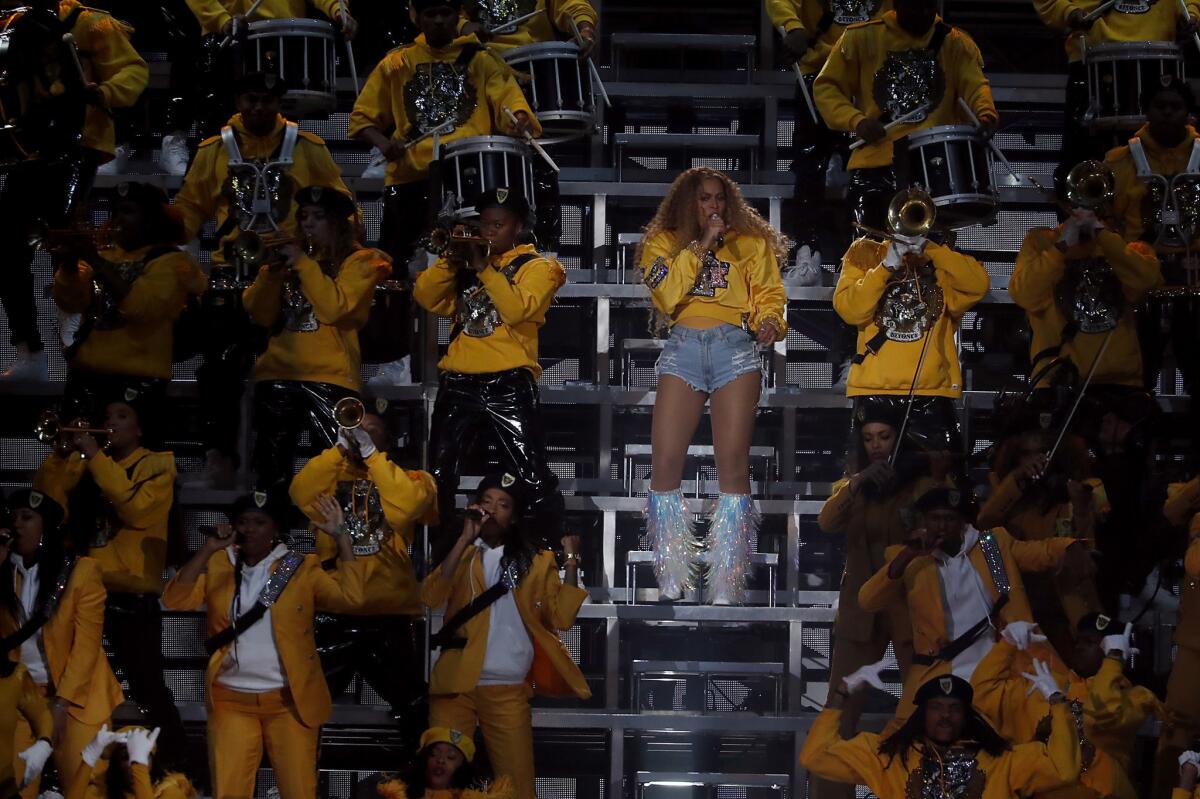
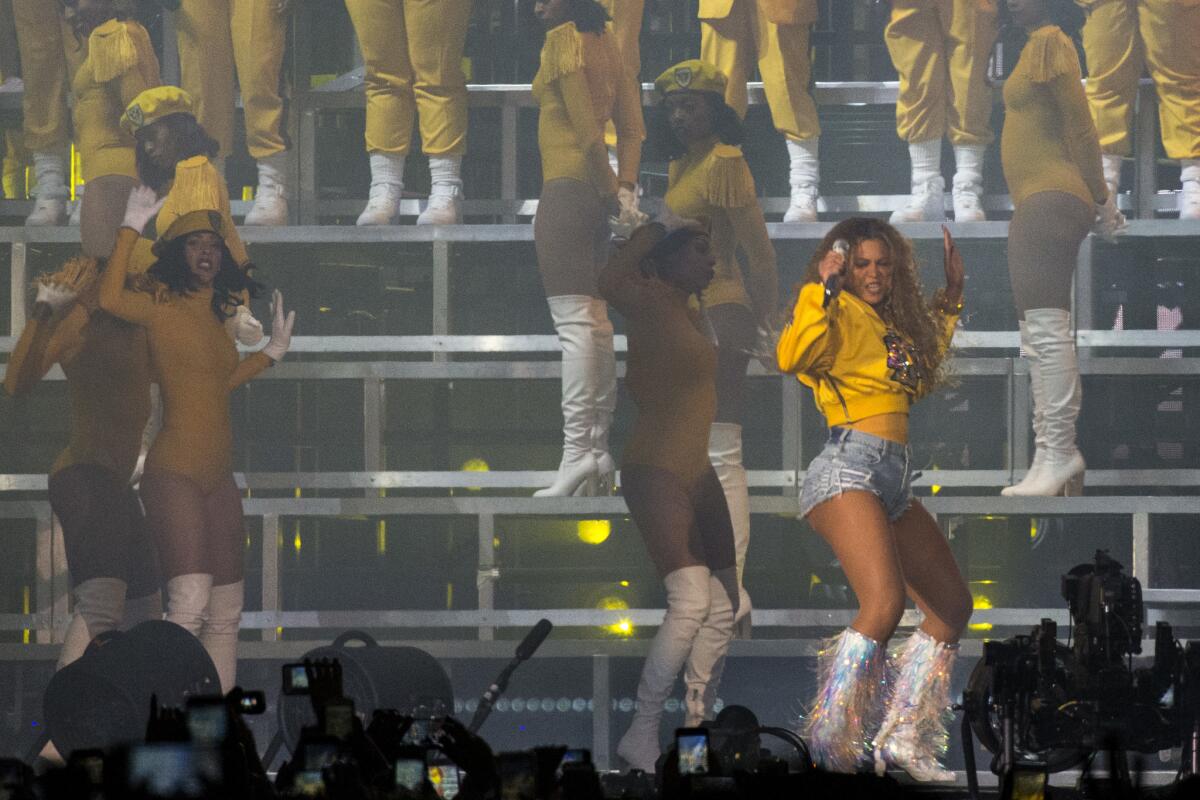
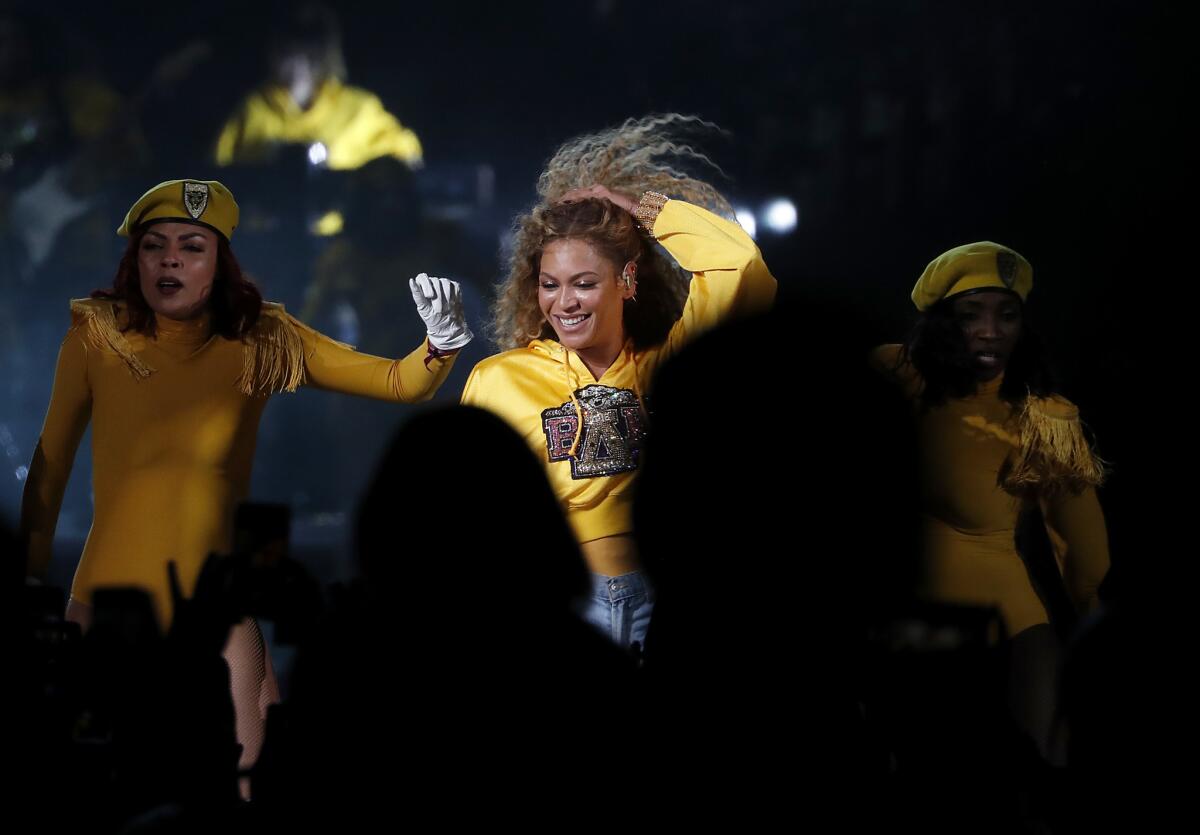
5 minutes with 19-year-old Coachella wunderkind Declan McKenna
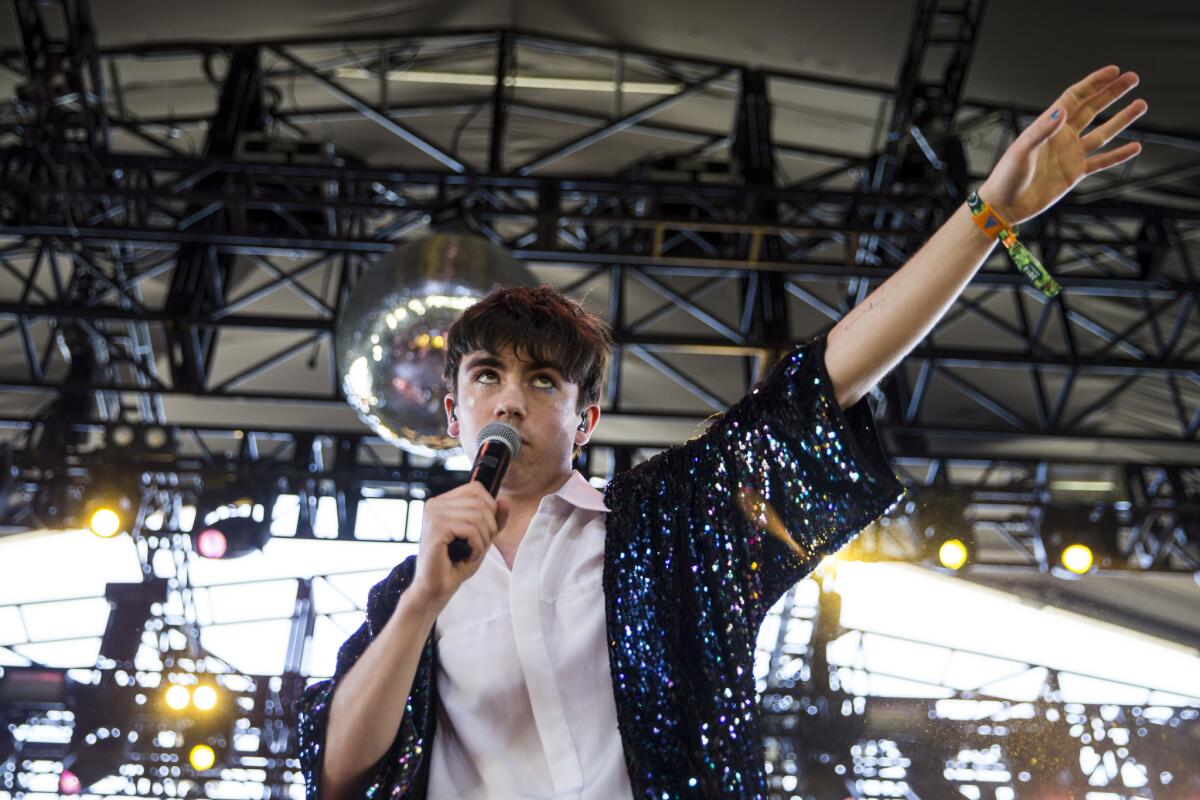
London’s Declan McKenna, at age 19, hasn’t been the youngest performer to play this year’s Coachella — that would be 11-year-old Mason Ramsey, the Walmart yodeling kid who appeared on the Sahara Tent stage with electronic dance artist Whethan. But the politically minded McKenna was one of the only teens to play the festival. He took time after his set to talk issues, Trump and his first-ever festival.
How did your first Coachella go?
It was a great show. I didn’t really know what to expect. We had a really good crowd. We were able to warm everyone up and have a really good time. I think it’s not often that you have a festival show that feels comfortable onstage but we all came on and we were really happy so it was great.
Who else’s set are you excited to see?
I mean obviously Beyonce’s playing so it’s kind of the thing to see tonight. So I’ll stick around for that and a couple of other shows. Like David Byrne, who I really want to see.
You’re known for being outspoken in your music. What are some issues on your mind today?
All sorts of things. I talk about a lot of things in my music. At the minute, there are a lot of issues around young people and voting. And that’s really close to me. I talk as well a lot about religion and how that impacts our society, especially over here. And that causes problems for LGBT kids and people like me.
How do politics here compare to in the U.K., where you’re from?
It’s so different. It’s hard to keep up with both. When I’ve been out here, it’s so in your face because even the comedy shows on TV are all talking about politics now. It’s almost commodified in a weird way. It’s so different. The political climate is strange but I think the similarities are that a lot of people are very frustrated with the situation at the moment, both across the pond and over here. Very frustrated with the decisions that have been made and how that impacts us and how that impacts our future.
How does it feel to be one of the youngest people playing at Coachella this year?
It feels great. I was so excited to play here. It’s such a cool thing to be able to come to a festival for the first time, especially one that’s so highly spoken of and such a big deal. So it felt great to play earlier. It’s nice to have a bit of time to relax later as well. It’s really, really exciting. I’m only on the first record that I’ve put out and still touring that and able to do festivals like this, it’s great.
When can we expect new music from you?
I’d like to think not too far into next year. I’m working on stuff and I’m going to take a little bit of time off after we finish touring in a couple weeks and then...I’ve got a lot of songs that I really really like so...really not too far from now I’d like to think.
Any last words?
Don’t vote in Trump again! [laughs] For your own good.
Scenes from the second day of Coachella
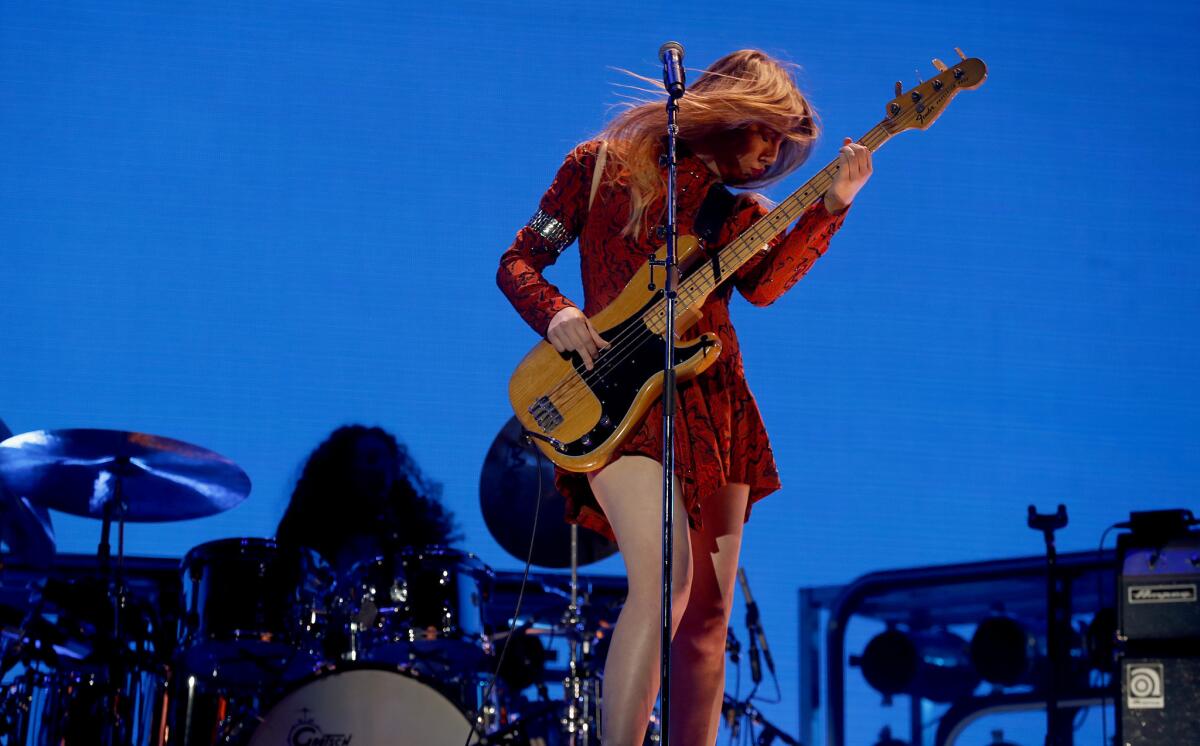
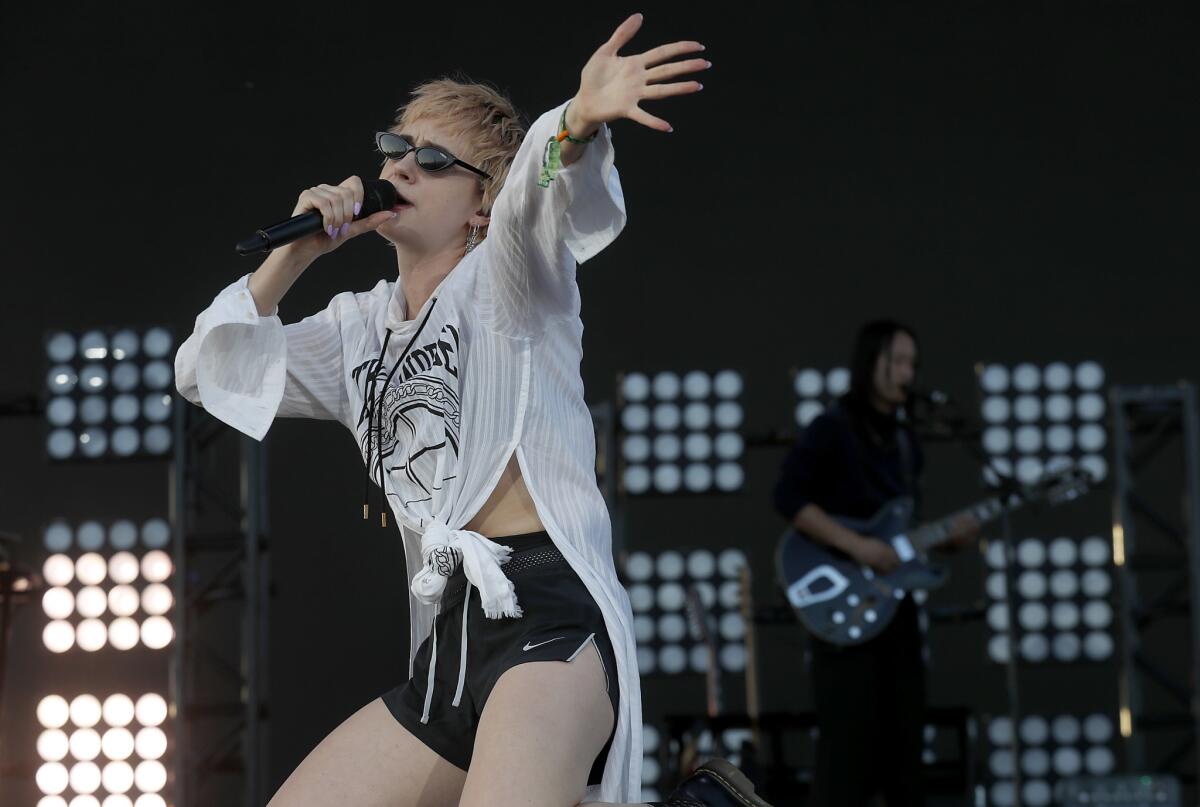
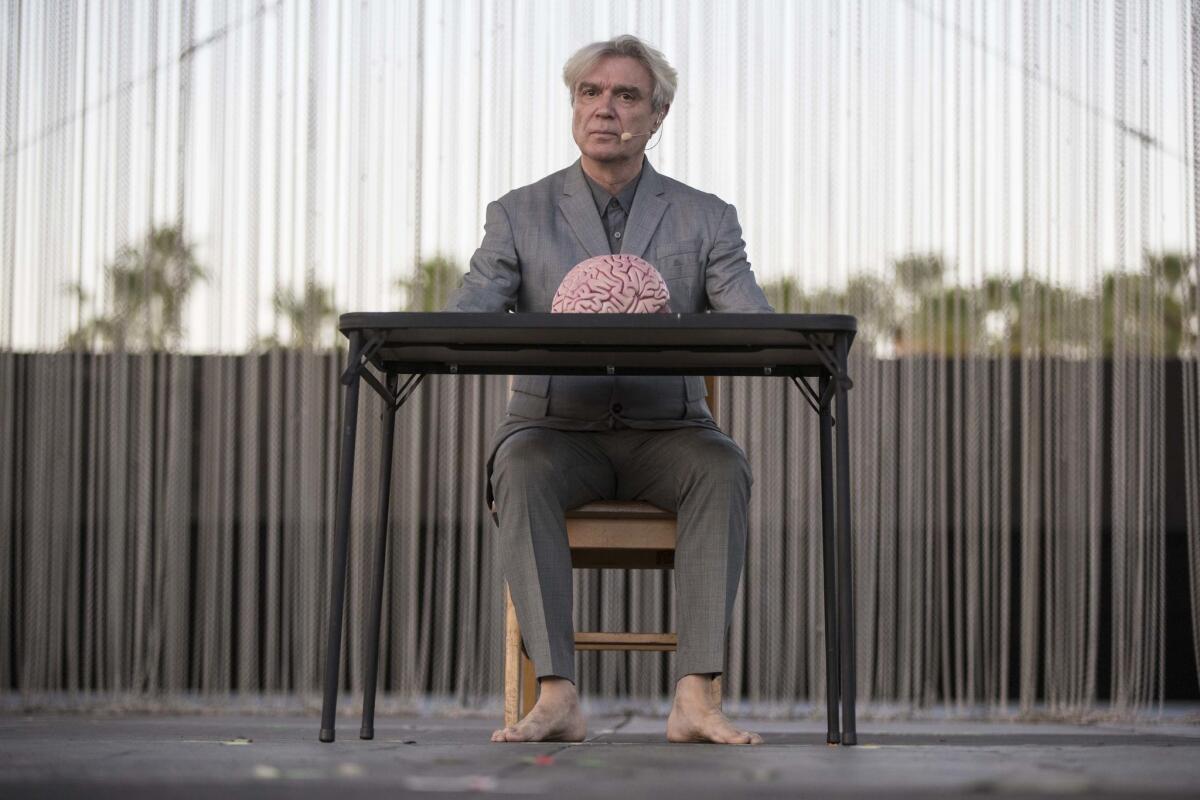
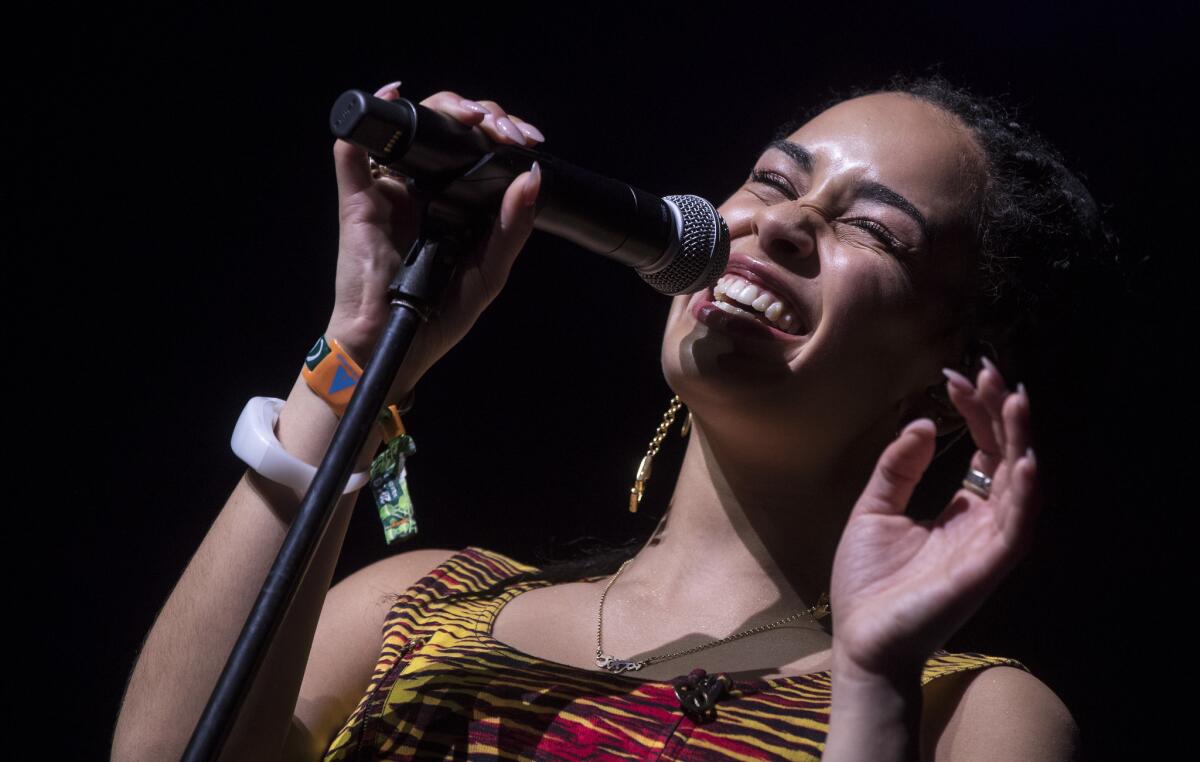
An informal poll of festivalgoers confirms the obvious: Everyone is there to see Beyoncé
In news that surprises no one, the main draw for many of the tens of thousands of people attending the Coachella Valley Music and Arts Festival was one performer in particular.
For Atlanta native Sade Douay, the impetus behind coming out was a no-brainer.
“Beyoncé of course, hello,” said the 32-year-old. She said the “music and the vibes” were also a major draw.
“It’s something I’ve always wanted to do,” she said. “Well, for like the last year.”
Douay, who was also excited to see Cardi B and Alina Baraz perform, was not put off by the exorbitant sticker price for Coachella tickets.
“For all these bands that’s good,” she said of the price. Douay also mentioned that she’d be ready to grab tickets for next year’s festival as soon as they drop to get them for “cheap,” as compared with the last-minute markups, when GA wristbands can go for as much as $700.
Boston native Ally McGinsey, San Francisco native Carina Fish and their friend Ashley, all 26, originally planned to attend the festival last year and were disappointed when Beyoncé canceled. But this time? “Beyoncé or bust,” McGinsey said.
“I’m here for Beyoncé,” agreed Fish. “Everything else is awesome.”
The three women, who camped out on the festival grounds, were also drawn by the EDC performers playing this year. Despite the high ticket costs, the three women said they felt the experience was well worth the price and fully intend on coming back next year.
Erica Sherman, 26, of San Francisco came back for the second consecutive year with one of her best friends. “We call it our Chella-versary,” she said.
Sherman came in a large group of friends and was excited to see Kygo, Alina Baraz, Beyoncé , The Weeknd and SZA.
“It’s always a good experience,” she said. “Especially when you come with a lot of good people.”
Phil Gibson, 33, from Washington, D.C., was one of the rare festivalgoers who came to see someone other than Queen Bey.
“I definitely wanted to see The Weeknd,” he said. “It was a great set.”
But, Gibson said, he planned to stay to see Beyoncé as well.
“Beyoncé, yeah,” he said with a shrug. “I mean, she’s cool too. But I figured if Beyoncé is here she’ll probably bring out somebody… and everybody is thinking it’s probably Jay, you never know though.”
Though it was his first time at the festival (or perhaps because of it), Gibson had no complaints about the price tag.
“It’s always worth it, no matter what,” he said. “It doesn’t matter if you get it way in advance or if you get it the very day before. You’re still going to enjoy it. If you really want it you’re going to spend whatever for it so it’s whatever.”
“I wish I could just stay here for the rest of the week,” he said. “And just feel the same feeling I have.”
Meet professor Nile Rodgers, faculty member at Coachella U
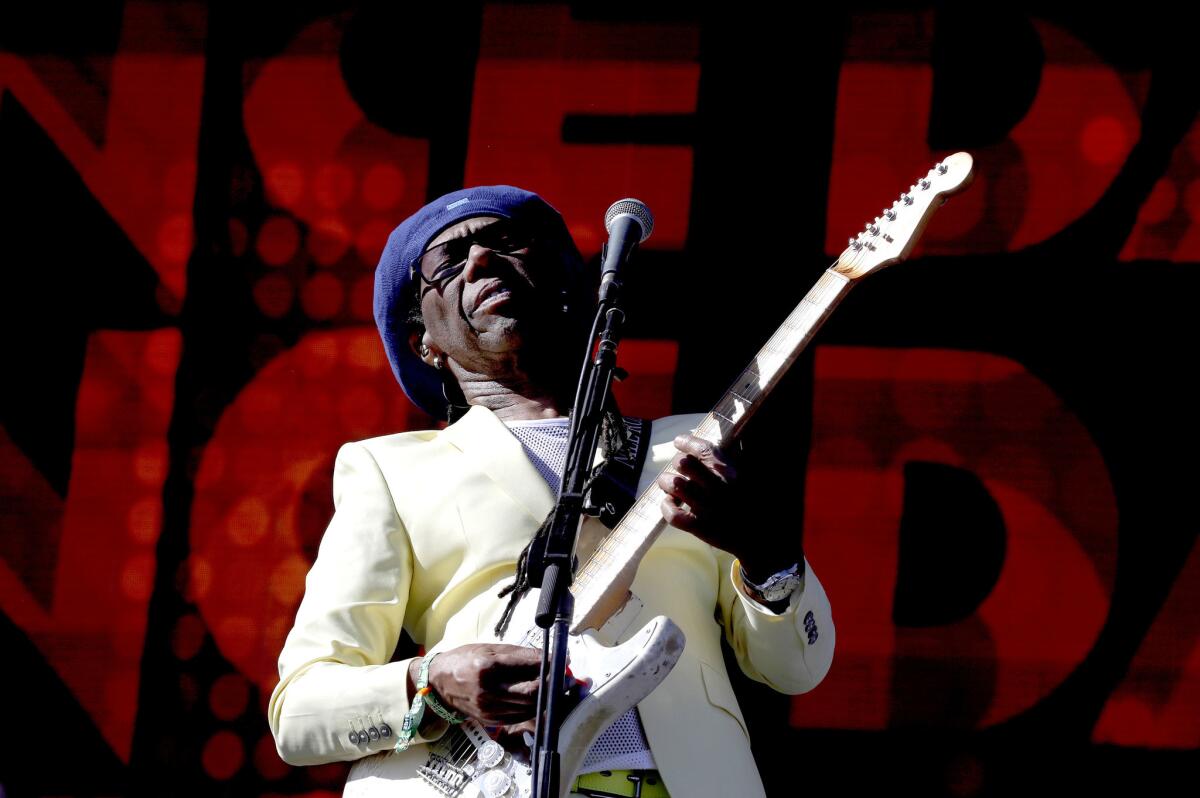
Coachella has worked hard over its nearly two decades to make itself known as a place to see emerging talent — and as a place that can boost that talent to the next level.
But the festival typically saves room for some influential old-timers too, and Saturday it presented memorable performances by Nile Rodgers’ Chic and David Byrne of Talking Heads.
Leading a smartly attired version of the disco band he and the late Bernard Edwards founded in the mid-1970s, Rodgers structured his set as a kind of history lesson laying out the many, many pop hits he’s responsible for writing or producing, including Chic’s “Everybody Dance” and “Good Times,” as well as David Bowie’s “Let’s Dance” and “I’m Coming Out” by Diana Ross.
The result was as as irresistible as it was educational.
Byrne put across a professorial vibe as well as he did tunes from his brainy new solo album, “American Utopia,” along with Talking Heads classics such as “Once in a Lifetime” and “This Must Be the Place (Naive Melody).”
Dressed in a crisp gray suit, the post-punk veteran was schooling Coachella’s kids on the illusory nature of the American dream.
But he was doing it over grooves that wouldn’t quit.
The long prelude to Beyoncé leads fans to First Aid Kit and Angel Olsen
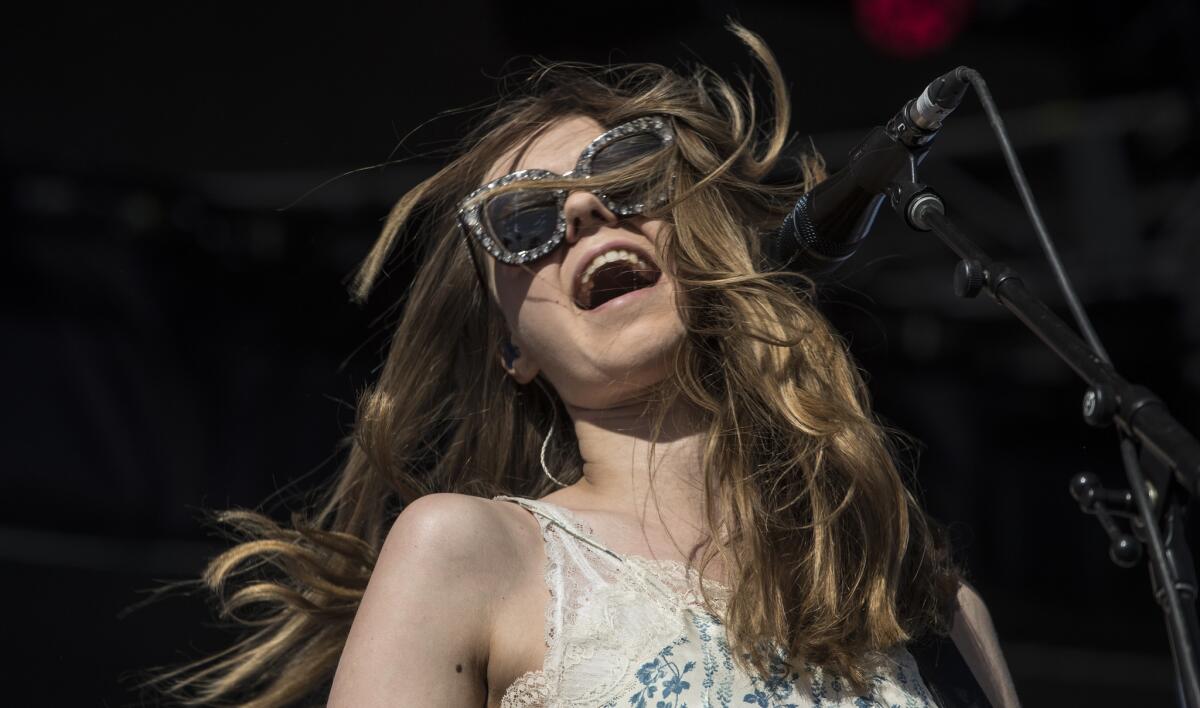
“Time cannot pass!” screamed one shirtless fan as he ran across the main Coachella concourse around 5 p.m. Saturday. He embraced his other shirtless dude friend. “Please let this day last forever.”
Well, sir, if time didn’t pass we wouldn’t get Beyoncé later. Your premise is flawed. But hey, the sentiment’s accepted.
On the afternoon of perhaps the most anticipated Coachella set in the festival’s history, it was all smiles as the logistical hiccups of the first day (brutally long entry lines, a confusing new layout) eased up a bit and everyone found their old Coachella groove again. The early-shift sets were well-suited to a day when everyone knows the epochal event to come but still is riding high with the anticipation.
Angel Olsen and First Aid Kit each looked to pre-Beatles rock and country for inspiration, catching the day’s desert winds in perfect form. The Swedish folk duo First Aid Kit’s “Emmylou” overtly carried the torch for classic L.A. cosmic country, shouting out Emmylou Harris, Gram Parsons, and Johnny and June Carter Cash as romantic heroes for all time. (Emmylou definitely would have approved.)
Olsen, meanwhile, was as wise-cracky as ever, joking with a guest-singer friend that their endearingly improvised duet was “livestreaming so we can look at it later,” to their mutual disdain. They shouldn’t have worried. Songs like “Shut Up Kiss Me” were perfectly suited to this freewheeling afternoon.
Dance-wise, it was all Nile Rodgers from now until forever. Chic’s legacy is unassailable (Rodgers will tell you that himself), but any writer who can reach into his quiver and pull out “Get Lucky” and “Let’s Dance” without even dipping into his own catalog is truly beyond peer at a show like this. It’s hard to say if music truly helped Rodgers beat cancer, but darn if it didn’t feel like it out there.
In the Yuma tent, Yaeji had some of the longest lines of the day, and justifiably. the Korean American producer, sometimes-rapper and DJ splices all the sounds of the moment (woozy hip-hop, hard-edged house and a hook-centric cadence catchy in any language) into an undeniably compelling aesthetic. It’s great on record but even better live when she commandeers the mic. The underground-focused Yuma tent is usually locked in on high-octane DJ work, but Yaeji is a rare star with potential to go far, far beyond it.
Eminem has a Mom’s Spaghetti pop-up restaurant at Coachella
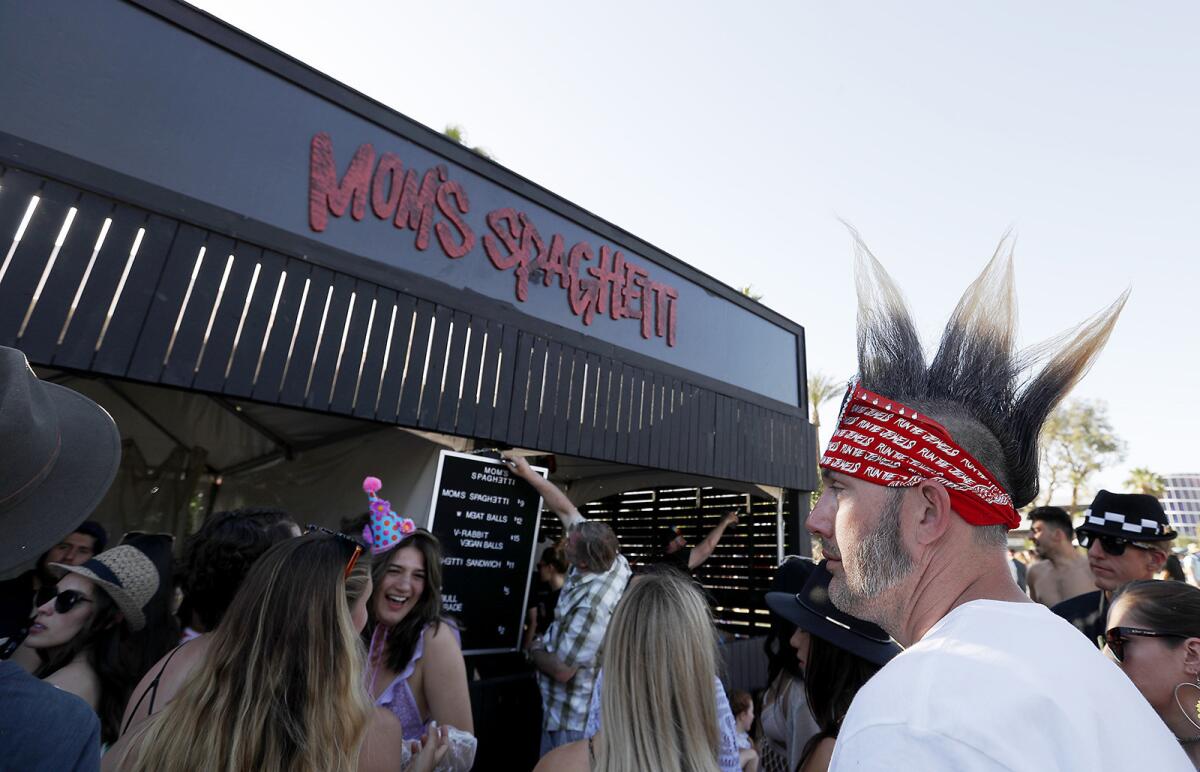
Prepare to lose yourself in spaghetti.
Eminem (the artist and actor whose real name is Marshall Bruce Mathers III), has opened a Mom’s spaghetti pop-up restaurant at this year’s Coachella Valley Music and Arts Festival.
The name, of course, is a reference to the famous line in his 2002 song “Lose Yourself.” It goes: “His palms are sweaty, knees weak, arms are heavy. There’s vomit on his sweater already, mom’s spaghetti.” And fans everywhere have been singing about soiled sweaters and Eminem’s mom’s spaghetti ever since.
The booth is located in general admission near the Do L ab tent.
The pop-up window is serving spaghetti, only instead of coming from Eminem’s mom’s kitchen, it’s made by a local commissary kitchen.
You can get a take-out container of spaghetti ($9), add meatballs ($12) or get a spaghetti sandwich ($11), which is basically three forkfuls of pasta and a couple rounds of mozzarella between slices of garlic bread.
The spaghetti is a cross between something you might have had at your high school cafeteria, and a dish your mom actually may have served when you were a kid. And there’s something nostalgic about the way the noodles are the opposite of al dente.
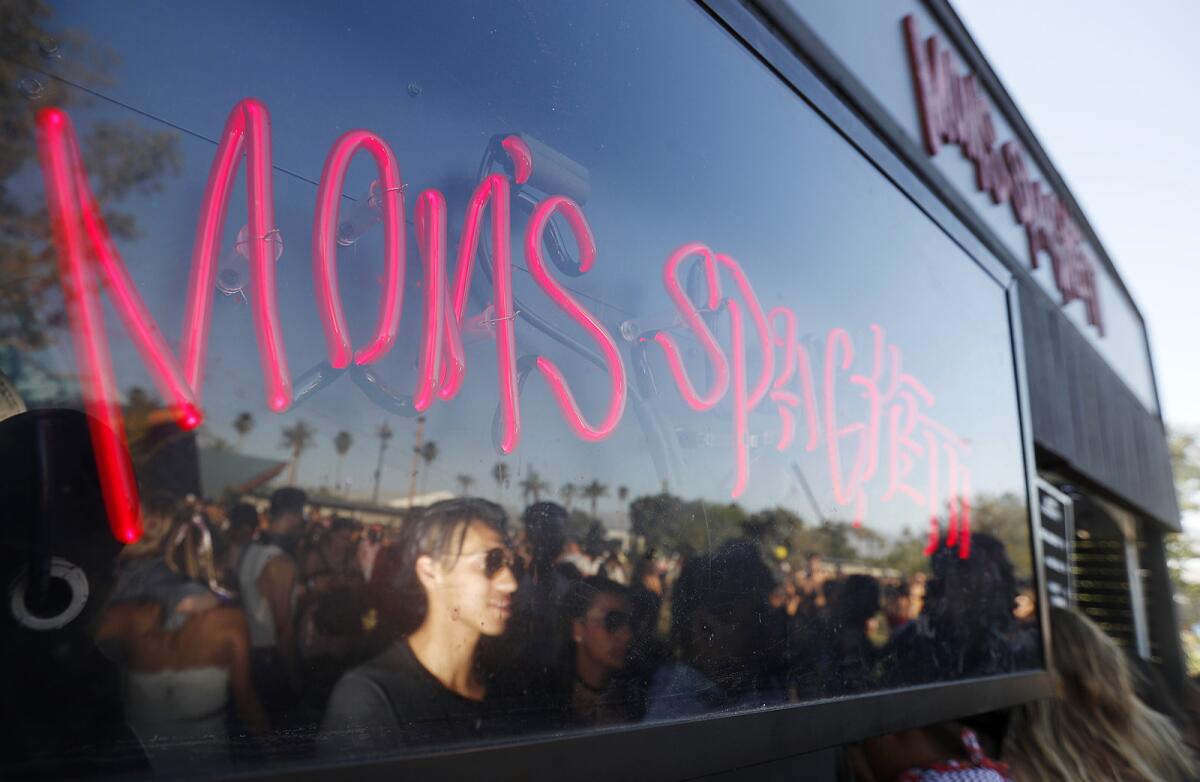
Most of the fans waiting in line at the booth made the Eminem connection as soon as they saw the name, written in bright red neon.
“I just assumed it was related to him because we’d never heard ‘Mom’s spaghetti’ anywhere else,” said GiGi Garcia, a 23-year-old from San Diego. “I want to know if it’s just this year because he’s playing, or if they will be here next year too. I bet the spaghetti is good.”
“It’s a brilliant name for a spaghetti restaurant,” said Megan Black, a 22-year-old from Toronto. “We were drawn to it because of the name.”
No word yet on whether Eminem will be eating spaghetti before his Coachella-closing set on Sunday.
Has Coachella’s boho-chic flower crown lost its petal power?
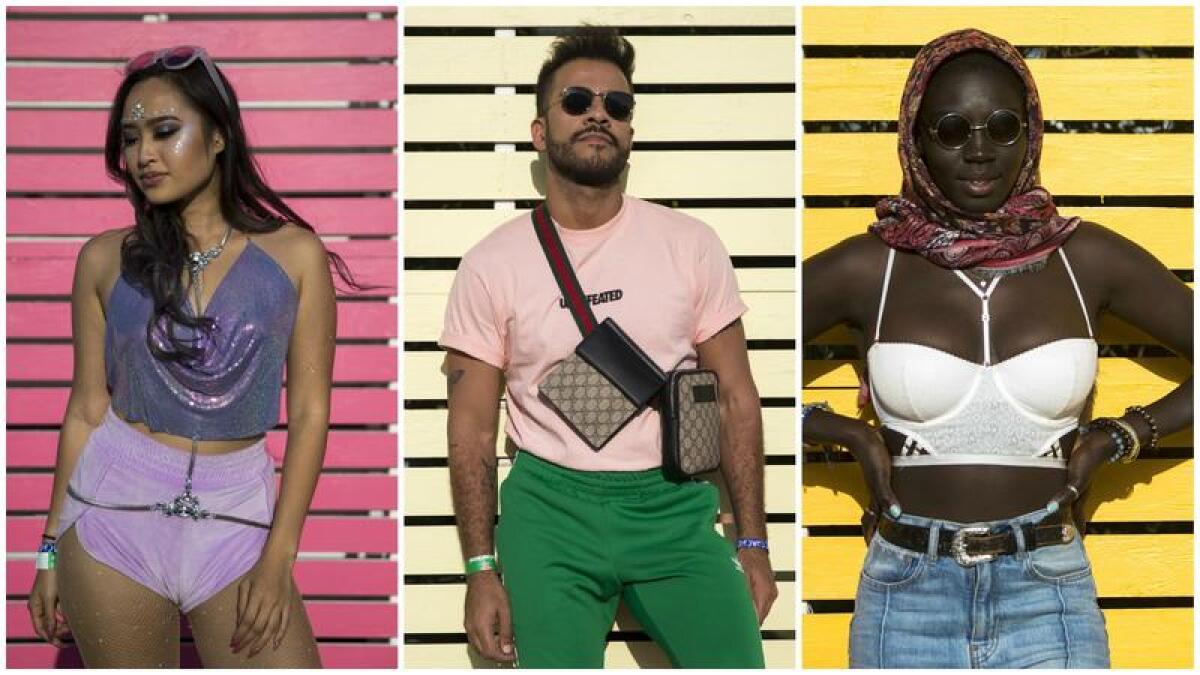
Sorry, flower crowns.
You were the reigning boho-chic accessory for countless Coachellas past thanks to Paris Hilton, Vanessa Hudgens and hundreds of others channeling their inner flower child. But at this year’s Coachella Valley Music and Arts Festival, it appears you have lost some of your petal power.
Perhaps you have become a victim of overexposure — too much Instagram play thanks to those Snapchat-filtered photos. And yet, there may be hope. If anyone can cause a crown revival to happen during the second weekend of Coachella that would be Saturday night’s headliner, Beyoncé, who favors wearing crowns in general. We’ll be watching when she takes the stage.
The other major fashion note from Coachella is the rise of streetwear, largely embraced by the millennials who make up the Coachella crowd. Streetwear, which has its roots in Californian surf and skate culture and is also a huge part of hip-hop culture, has become proper music festival attire, particularly styles from the 1990s, the decade that continues to influence fashion.
On a sartorial mission, we spent eight hours wandering the festival grounds on Friday, looking for fresh looks and to confirm our suspicions about trends. Here are fashion portraits we took showing some of the prominent looks from the first day.
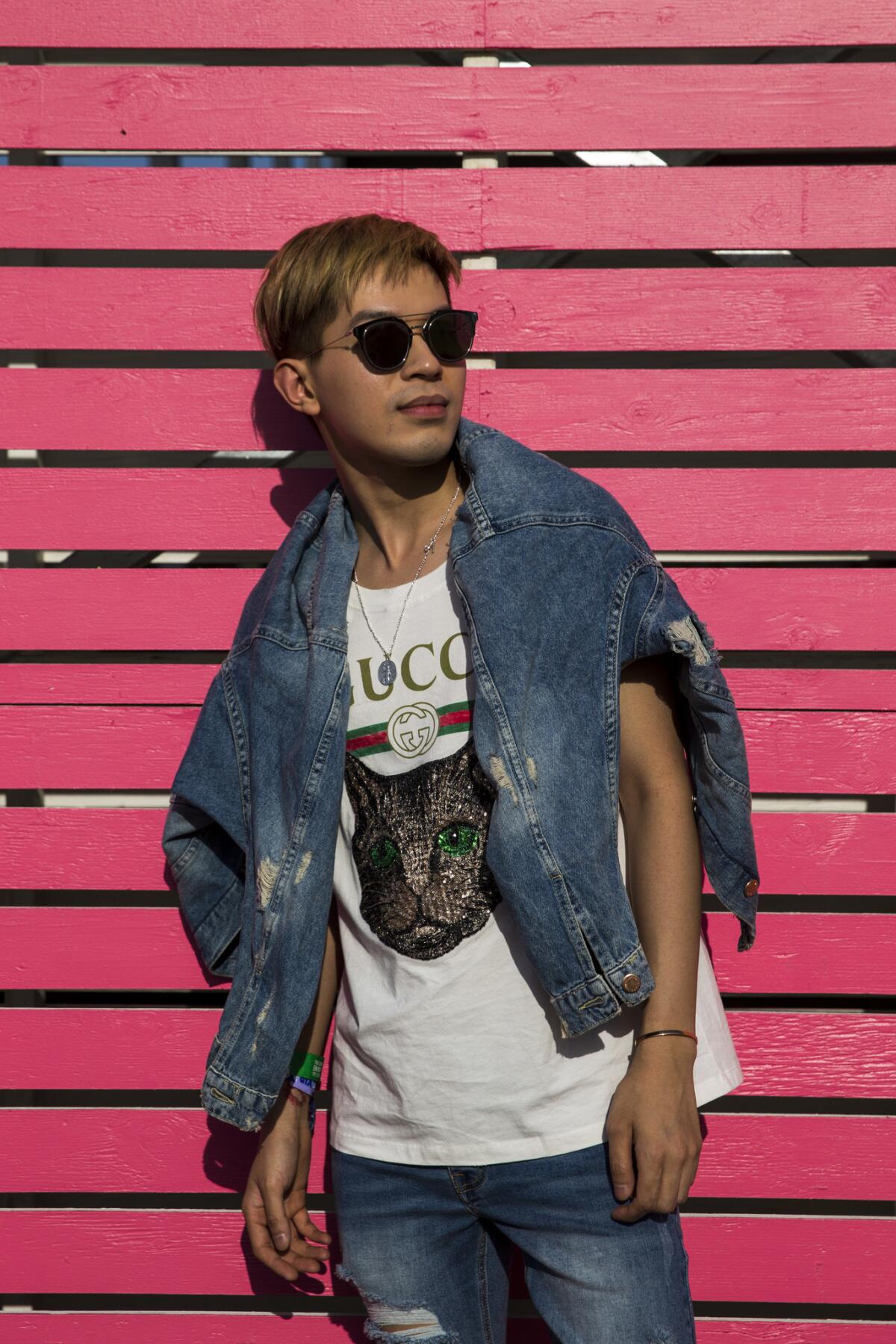
1. Gucci for the win?
During day one of Coachella, the Italian luxury brand’s interlocking double G logo popped on T-shirts, tank tops and an abundance of accessories. On a side note, Beyoncé and her daughter, Blue Ivy Carter, are often photographed wearing the label, which is thriving under the direction of creative director Alessandro Michele.
Face time with Coachella fans on Day 2
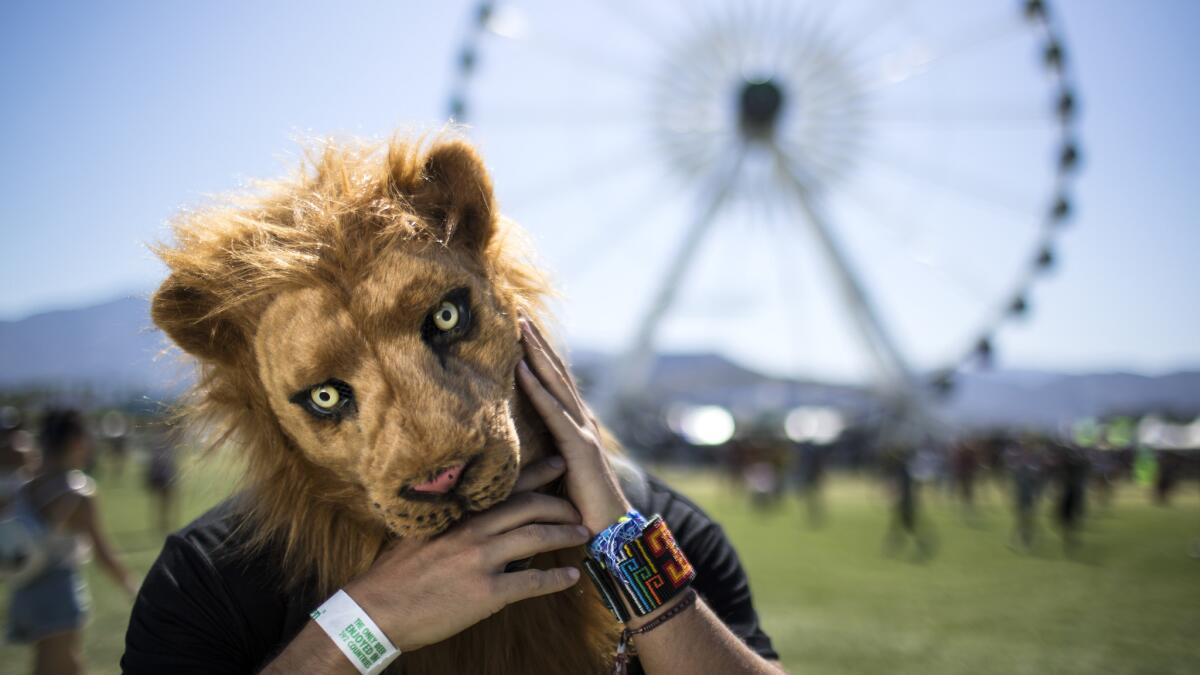
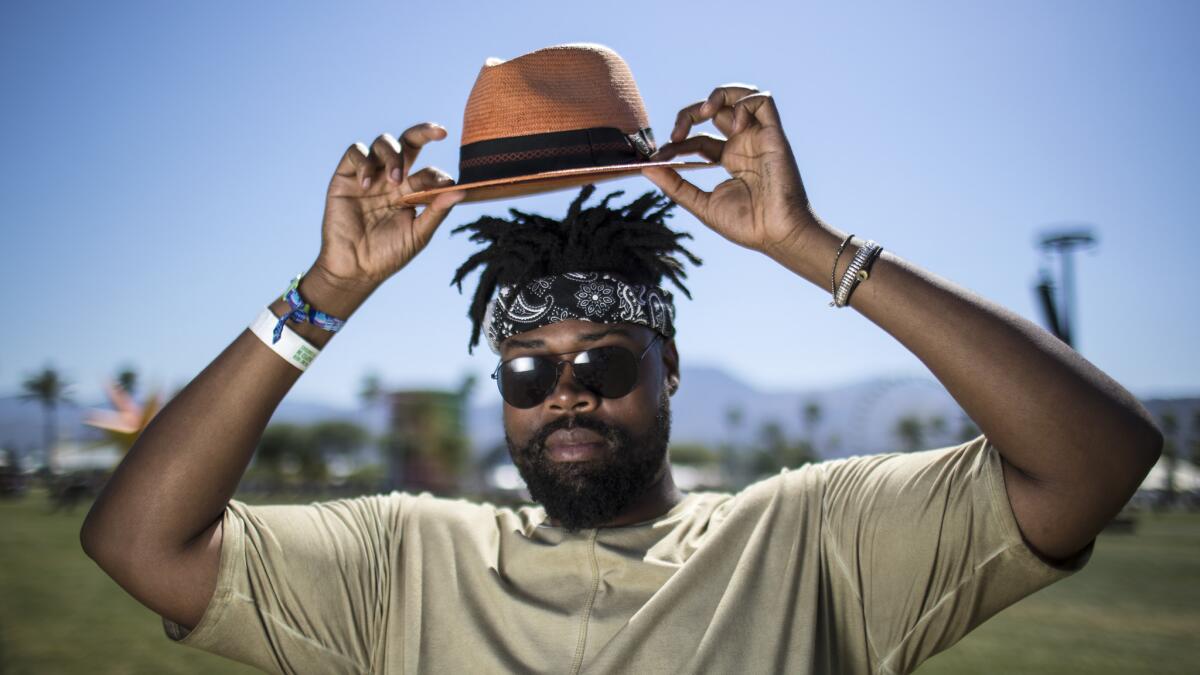
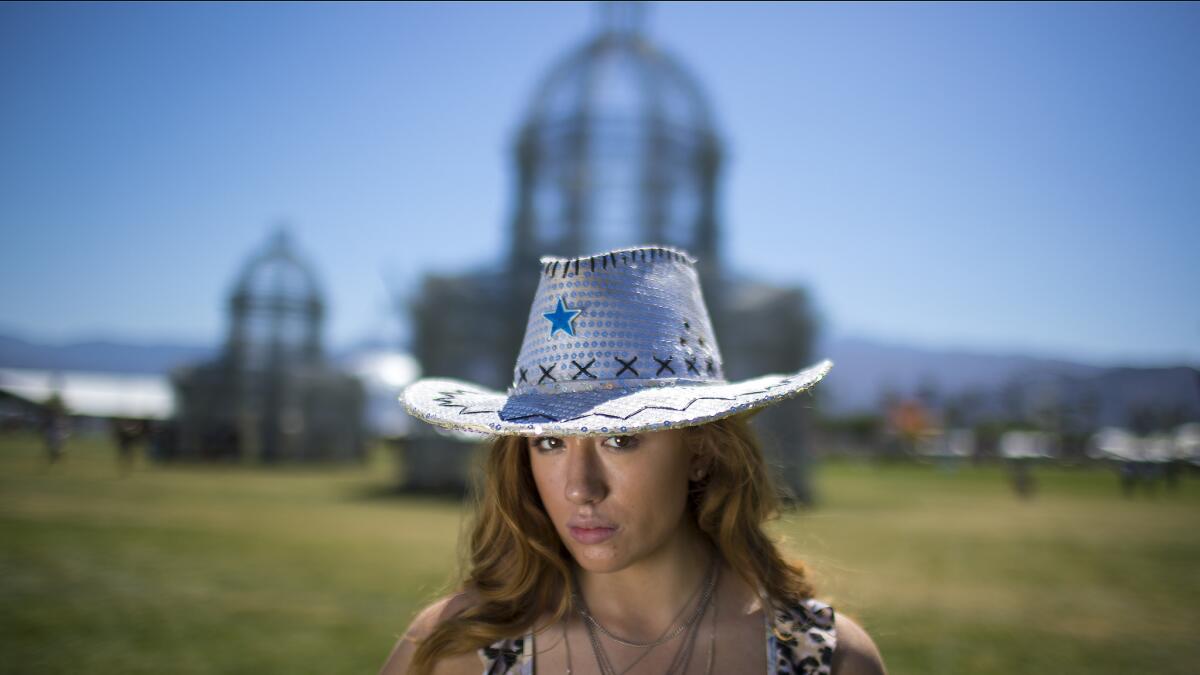
Sudan Archives shows that the individual persists amid Coachella’s plenty
With so many acts on so many stages, Coachella — a festival where Saturday’s headliner, Beyoncé, is expected to bring approximately 100 dancers with her — can feel inhospitable to the idea of a solo performer doing her thing up there all by herself.
But that’s what Sudan Archives did Saturday afternoon in the Gobi tent.
Dressed in queenly red-and-gold garb, the L.A.-based artist sang and played violin accompanied by clattering yet hypnotic percussion grooves, which she triggered on a small electronic box that served as her only bandmate.
Not long after, Declan McKenna performed to a small but enthusiastic crowd at the Mojave.
The young English singer-songwriter wasn’t alone; unlike Sudan Archives, he was backed by a sturdy four-piece group that included a handsome keyboardist who’d evidently forgotten his shirt (though not his khaki culottes).
Yet as he did his nervy viral hit “Brazil” — “probably the only song of mine you’re familiar with,” he said — McKenna put across the same sense of an individual with a personal story to tell.
The Weeknd shows a different side on the Coachella stage
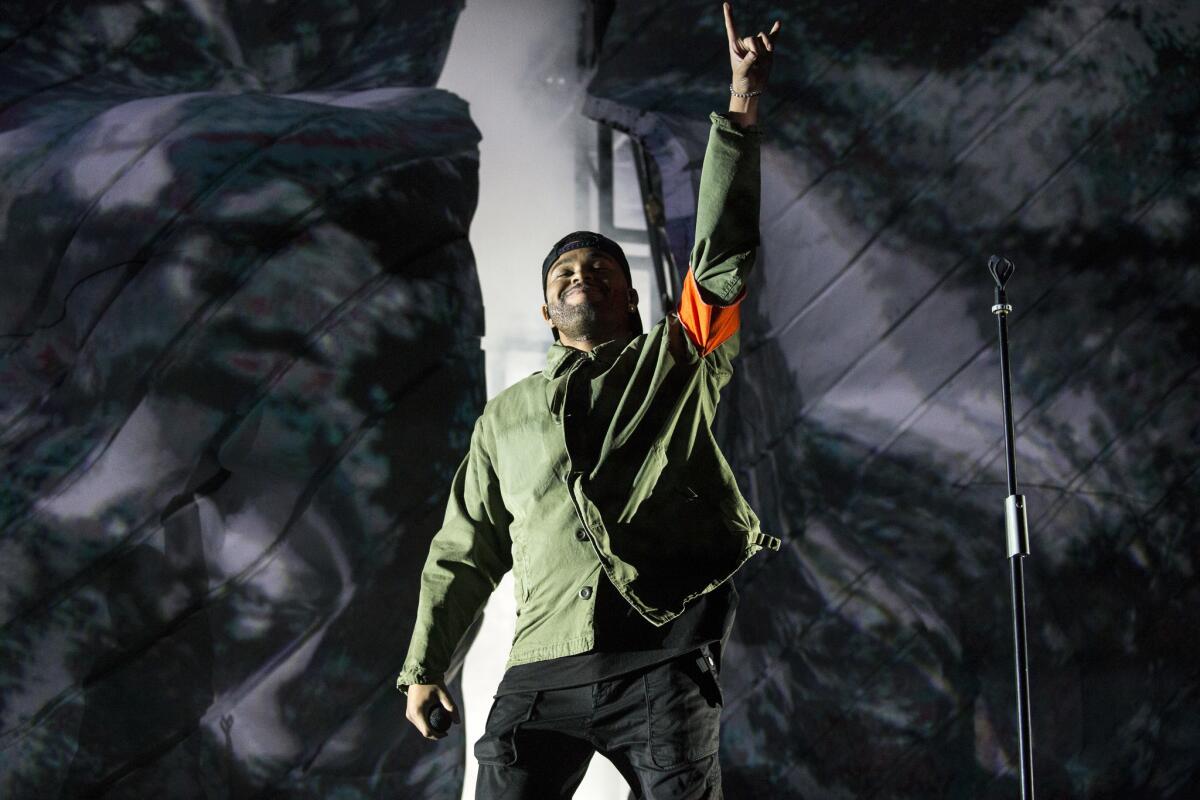
The first thing the Weeknd did when he came onstage Friday at Coachella — having emerged through a crack in an enormous mask that made the stage look like some otherworldly ruin — was grin.
And why not?
Headlining the festival’s first night, the Canadian R&B singer was peering out at a vast audience numbering in the tens of thousands, many of whom had watched him ascend Coachella’s ranks over the past six years — from shaky newcomer in 2012 to aspiring pop star in 2015 to the established A-lister who just topped the Billboard chart with an EP he released mere hours after announcing its existence.
Still, smiling enthusiasm is hardly the emotion on which the Weeknd built his famously tortured brand.
So it came as a welcome surprise to see how much pleasure he appeared to be taking in this very strong performance.
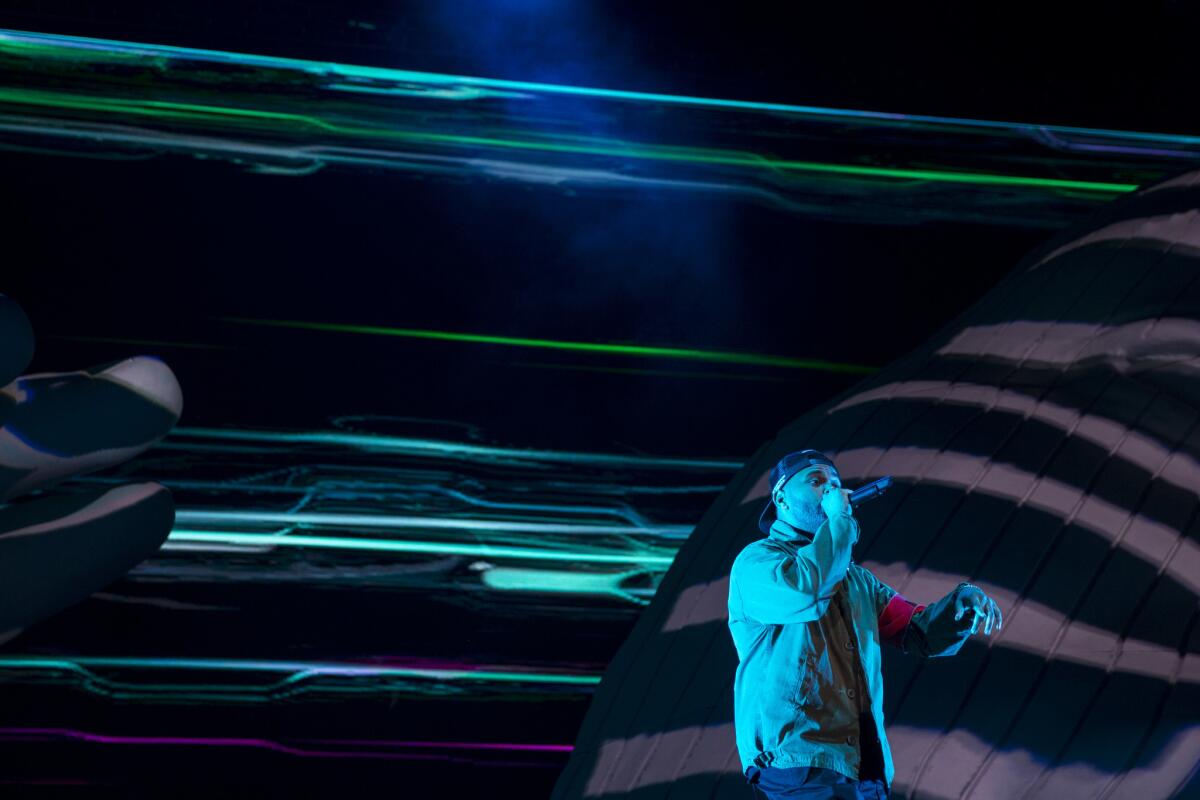
What we’re eating and drinking at the 2018 Coachella Valley Music and Arts Festival
The countdown to the moment Beyoncé takes the main stage at the Coachella Valley Music and Arts Festival is officially on. How should you occupy yourself while you wait?
Maybe two scoops of Van Leeuwen ice cream in a waffle cone. Or a mutli-course dinner from chef Curtis Stone’s Gwen pop-up restaurant. Tacos from Guerrilla Tacos.
Feel like a burger? Christian Page is cooking up cheeseburgers at the Cassell’s booth. And chef Shirley Chung (who is opening her restaurant Ms Chi in downtown L.A. soon) is making dumplings lashed with chile oil.
Lucky for you and your constant need for a snack (also known as your why-isn’t-Beyoncé-here-yet-distraction), some of L.A.’s best chefs are cooking at the festival.
And this year, Nic Adler, the man behind all the food and drinks, rolled out a new food hall called the Indio Central Market. Sound familiar? It was inspired by Grand Central Market in downtown L.A. and offers some of the best bites, and shade at the festival.
Check out the photo gallery below for a look at what we’re eating while we wait for Queen B.
PHOTOS: Coachella 2018 food and drinks
And if you want a full rundown of all the best food and drinks at the festival, check out our list here.
Electronic luminary Jean-Michel Jarre dazzles a Coachella that’s at a crossroads
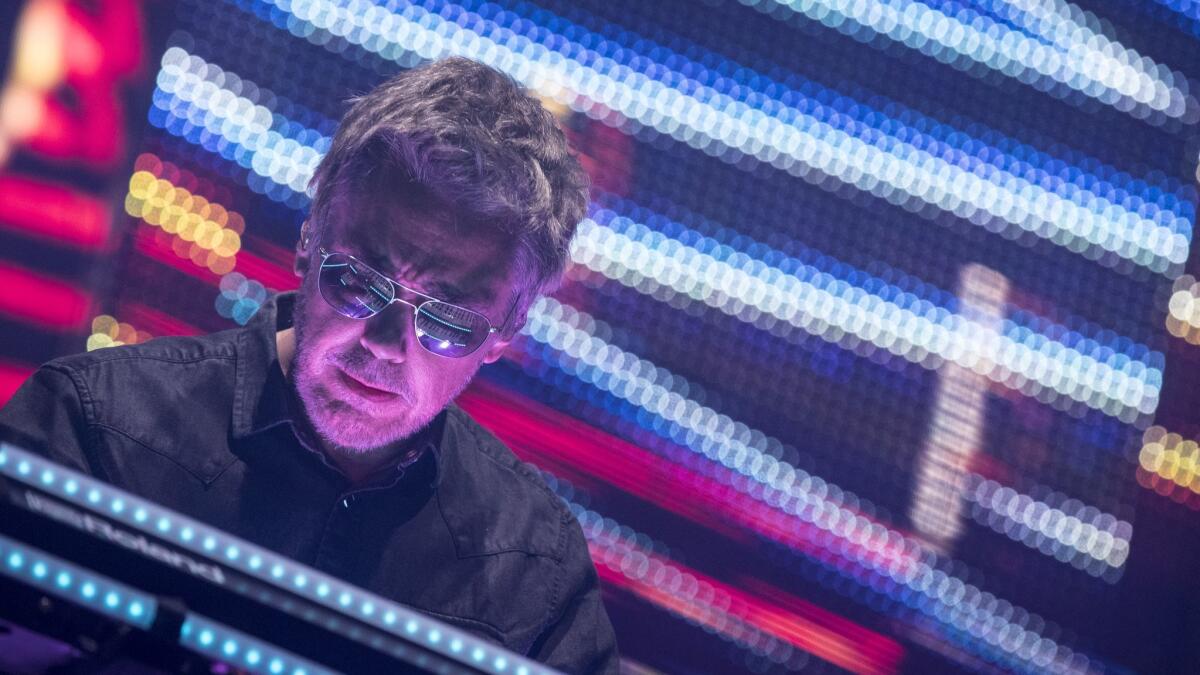
In 2018, Coachella is for hip-hop and R&B.
That much is certain, from the headliners on down. But it wasn’t that long ago that the festival had tilted hard to EDM, putting DJ-driven spectacles as grand finales and loading up the dance-focused Sahara Tent with as much LED firepower as it could muster.
A two-hour stretch after the Coachella dinner shift showed that the festival’s electronic music future is going to get weirder and better but also hokier and decidedly more lowbrow.
First, the bad news.
Instead of first-wave EDM acts like Calvin Harris or Swedish House Mafia — which at least had quality pop singles and could pull a consistent club set together — the last survivors of festival EDM are barnacles on the hull of the S.S. Coachella.
Kygo, the Norwegian “tropical house” producer, is a singularly loathsome figure for stripping nearly every element of substance from dance music (including catchy, repetitive uplift) and replacing it with pan flutes and steel drums designed to max out your credit card at fashion retailer Topman before you hit the booze cruise with your college buds. Naturally, he’s a superstar.
Deorro, meanwhile, siphoned out all the songwriting and big-tent appeal of EDM, leaving behind only a pile of warmed-over French and Dutch house synths and sneering pilfers of much better Latin club music. The low-rent circus scene onstage only added to the sense that this was a clown show. Naturally, he had a peak-time Sahara Tent show.
These are the signs of a cultural moment in terminal decline. But a fan could quickly shake it off with a quick pass through the smaller Yuma stage to see one of the festival’s more ingenious super-groups.
Detroit Love is a trio of groundbreaking deejays and producers from the Motor City: Carl Craig, Moodymann and their younger peer Kyle Hall. All three are essential, if mercurial, figures from the city’s techno history and present, grafting dusty soul vocal samples into hard-knuckled drums and frequent forays into jazzy experiments.
Put all three onstage at once, though, and they swing for the fences. Their set was a merciless masterclass in building a night from the most rudimentary pieces, taking a single bone-shaking drum loop and building off it until it hit an almost rapture. Then they’d drop a howling gospel or soul sample in on top, and the thing really would start to feel like church.
Across the Outdoor Stage, Jean-Michel Jarre was up to something much different but even more ambitious. The French composer was an early proponent of the synthesizer’s potential, not only to add to rock but to create entirely new universes, and he loved taking over public spaces with high-concept light shows.
His cosmic-sized ambiance and hulking arpeggios made him a progressive era superstar — this is music that feels mind-altering. His crowd sizes are instruments in themselves, as he had over 1 million for one legendary Bastille Day set in France.
His Coachella crowd wasn’t quite that scale, but the effect remained. This was the Hans Zimmer slot of 2018 — a composer using sheer heft to overpower an audience who might not know his face but certainly knows a spectacle when it sees one.
Jarre’s set covered his whole ’70s career prime, but the arrangements and visuals were never remotely dated. All you could do was find a spot of grass, look up at the stars and be overwhelmed.
Vince Staples brings out Kendrick Lamar to close Coachella set on what he called the ‘white people stage’
Vince Staples had a lot of people talking Friday night after the 24-year-old emcee dropped two bombshells during his set at the Coachella Valley Music and Arts Festival.
Staples performed on the festival’s main stage, calling it the “white people stage” and saying, “I know y’all don’t know who I am cause none of y’all look like me, but I don’t give a … .”
For his final song, he brought out surprise guest Kendrick Lamar for a performance of “Yeah Right,” a song featured on his 2017 album “Big Fish Theory.” The crowd, which many characterized as “dry” on Twitter, went wild once Lamar appeared onstage.
The California rappers have collaborated in the past on “Opps,” a song featured on Lamar’s “Black Panther The Album — Music from and Inspired By,” the soundtrack for Marvel’s “Black Panther.”
Whethan brings the yodel kid to Coachella and the internet freaks out
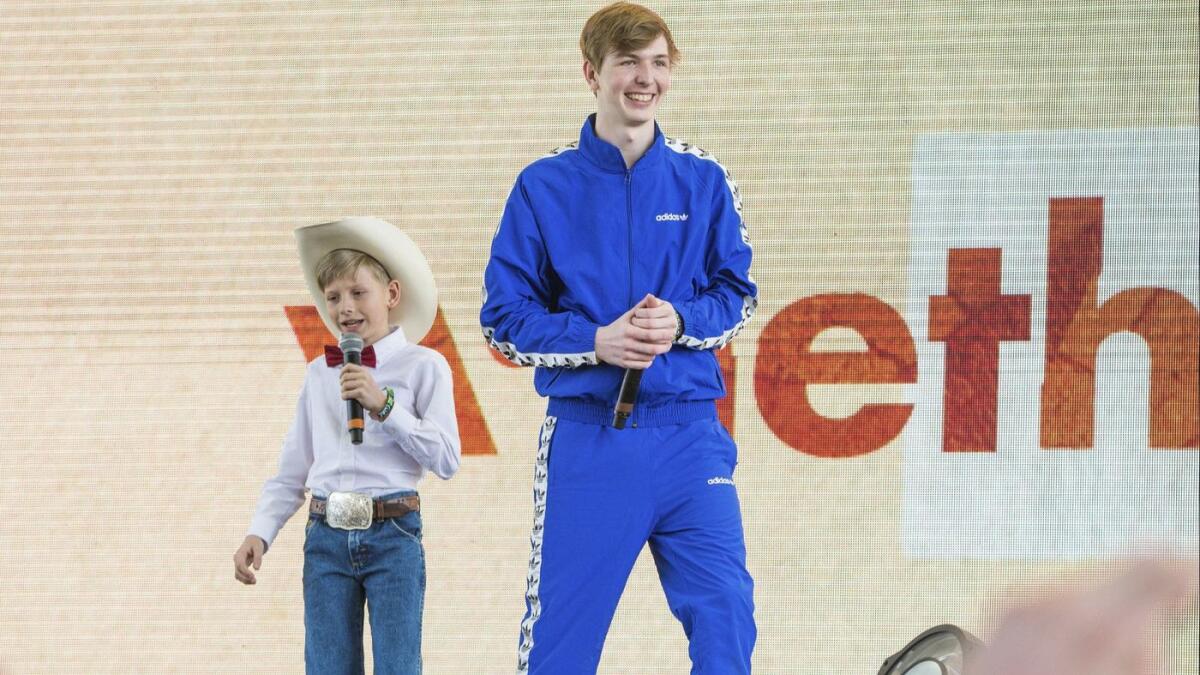
The Sahara Tent provided the clearest definition of what the Coachella Valley Music and Arts Festival has become when 11-year-old Mason Ramsey took the stage Friday afternoon alongside electronic dance artist Whethan.
Two weeks ago the preteen from Golconda, Ill., was unknown, and then a video of him yodeling in a Walmart went viral and he became an overnight sensation — with his own hashtags: #WalmartYodelBoy and #WalmartYodelingKid.
With few events as trendy as Coachella — just check your Instagram and Twitter feeds — it was no surprise Mason’s arrival was met with rapturous applause and not with the nod of irony one might expect.
“Everybody took your picture, right?” Whethan asked after the kid nervously pushed through a performance of the Hank Williams Sr. classic that made him a celebrity.
It was a moment that aptly distilled the culture of the festival as a can’t-miss destination for music fans — and those who just want to be seen.
Bleachers proves the spirit of ‘the Boss’ is alive and well at Coachella
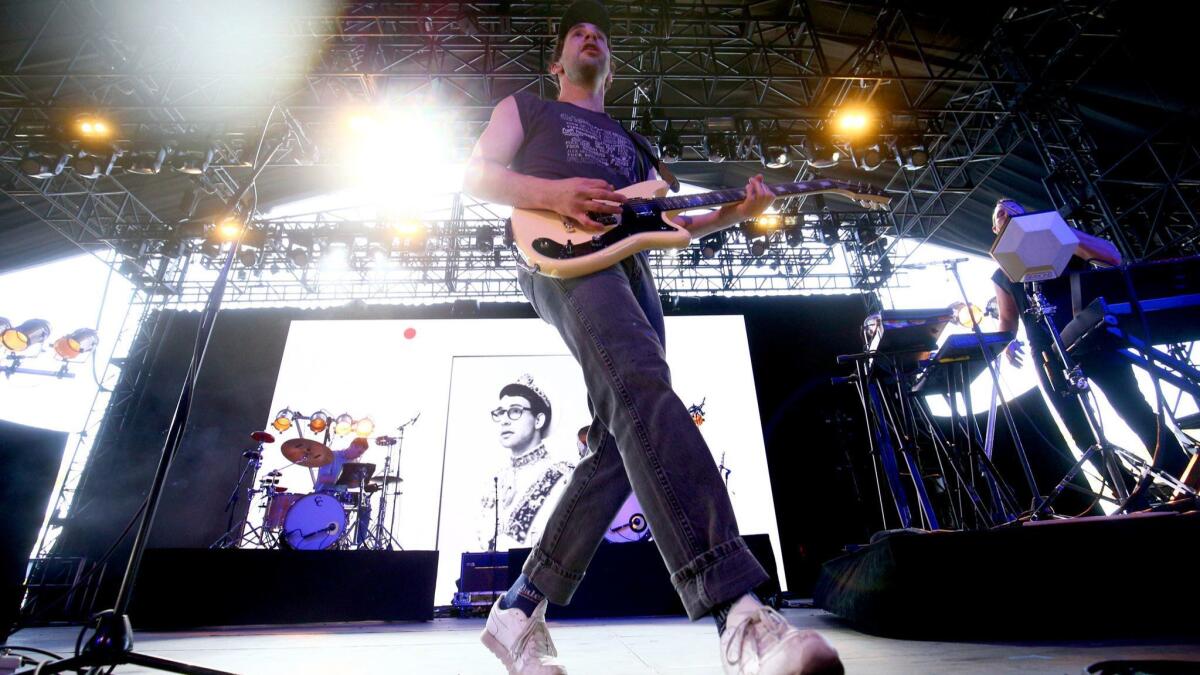
Jack Antonoff remade Bruce Springsteen’s boomer-friendly arena rock for a millennial audience as he led his band Bleachers inside Coachella’s packed Mojave tent Friday afternoon.
Wearing high-waisted dad jeans and a black sleeveless T-shirt, the singer and guitarist from Springsteen’s home state of New Jersey told the crowd that he’d written his sad songs all alone in his room — then added that they didn’t sound so sad now that thousands were singing along.
Antonoff, who’s also an in-demand producer for the likes of Lorde and Taylor Swift, brought out Carly Rae Jepsen to sing a pair of tunes: “Hate That You Know Me” and “Alfie’s Song (Not So Typical Love Song),” from the soundtrack of “Love, Simon.”
Scenes from the first day of Coachella
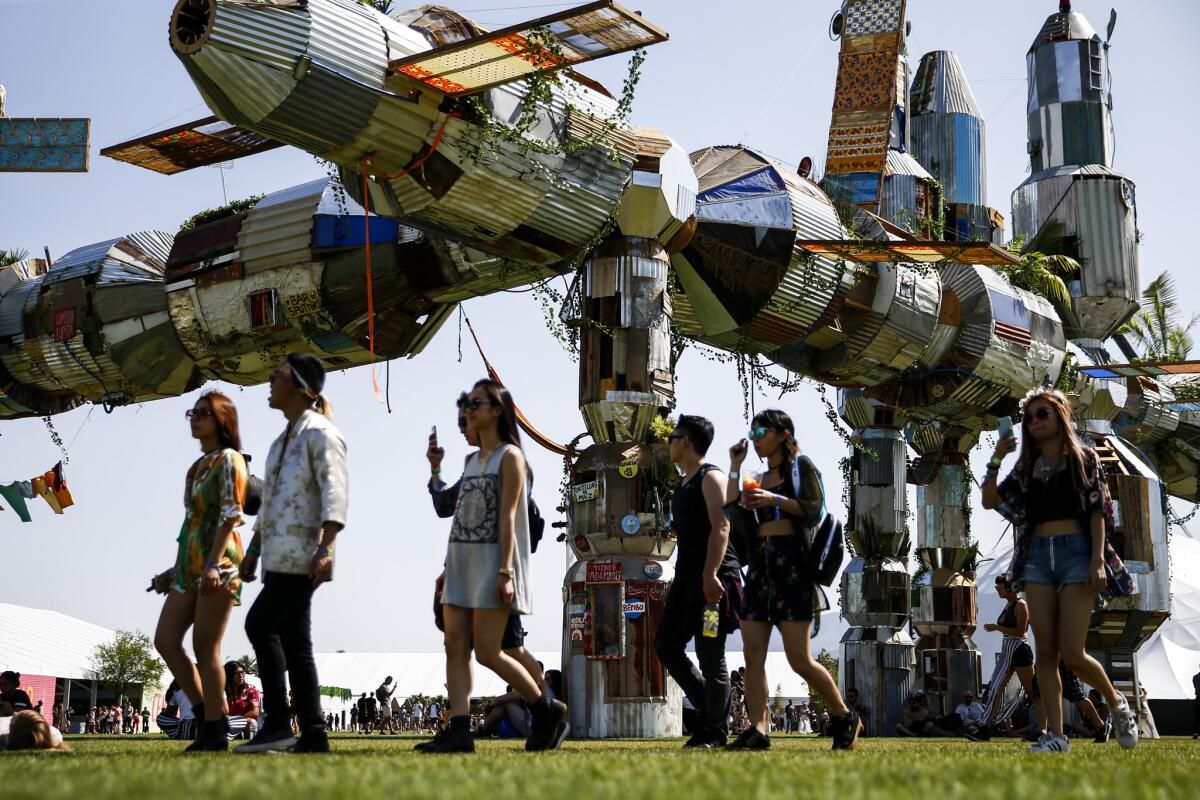
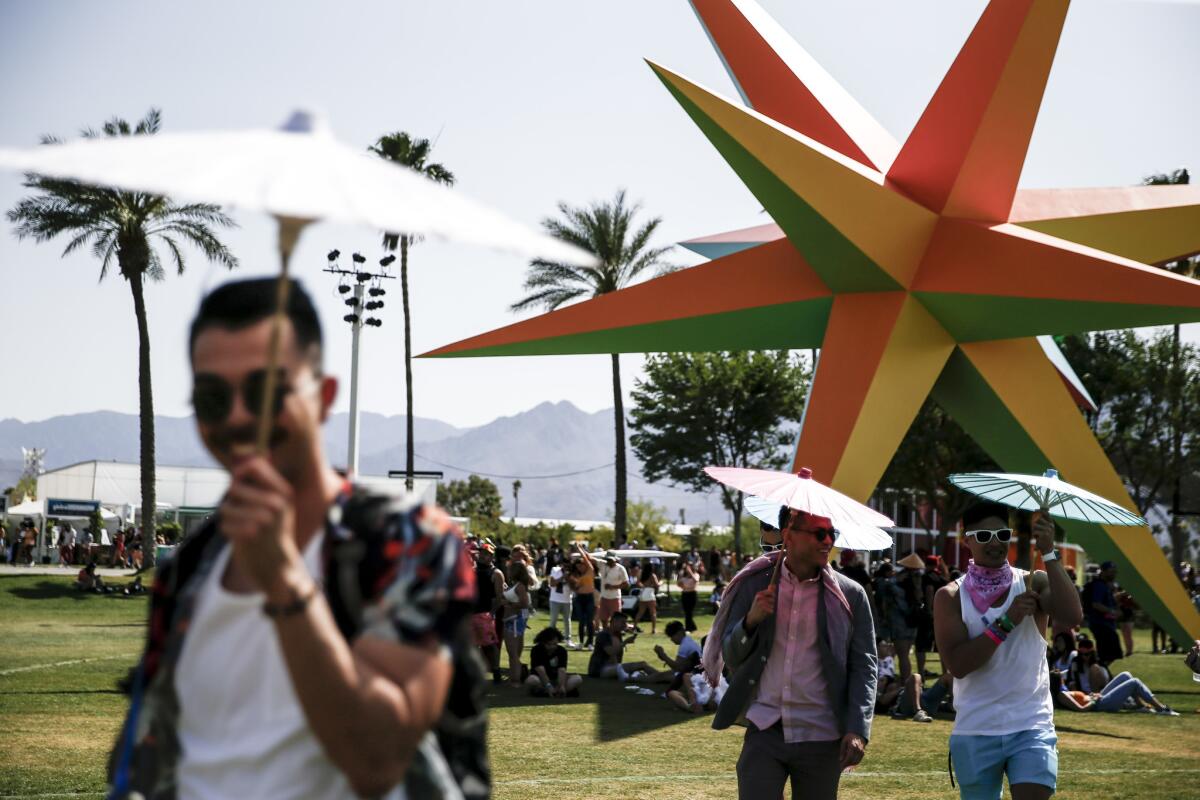
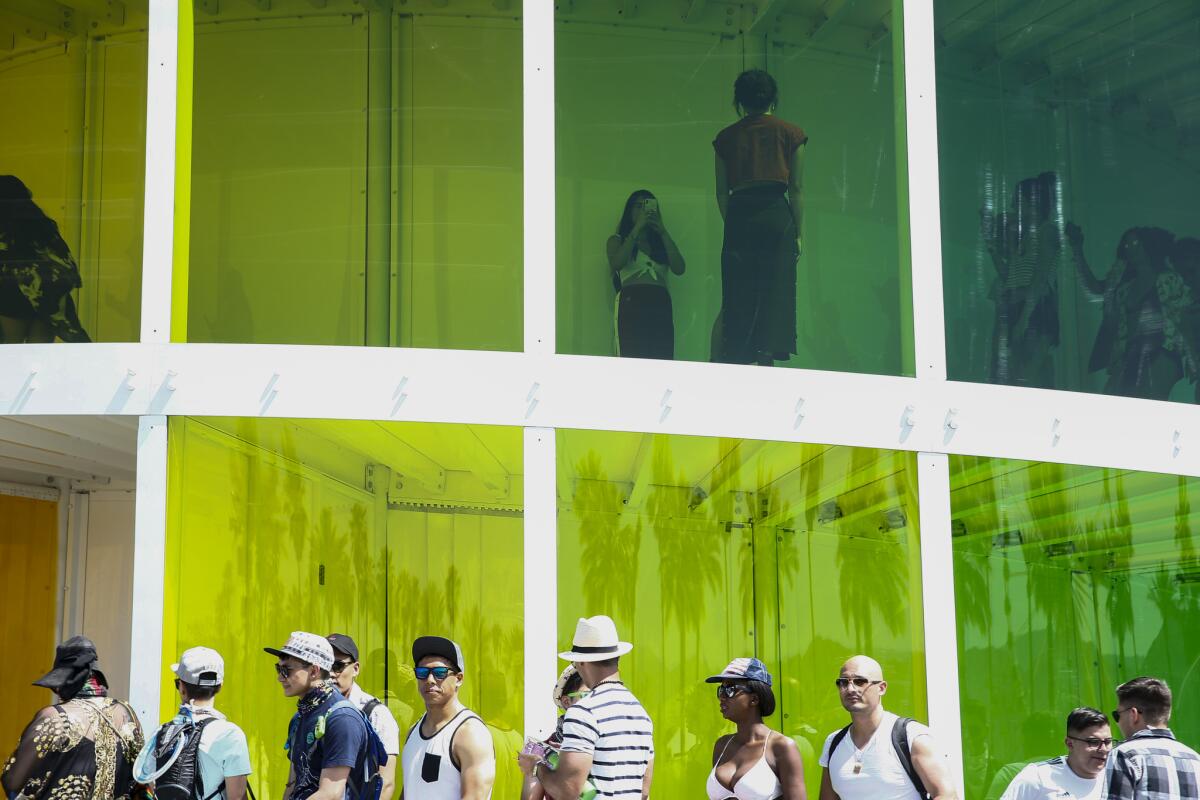
Kali Uchis’ ebuillent new tracks only add to the desert heat
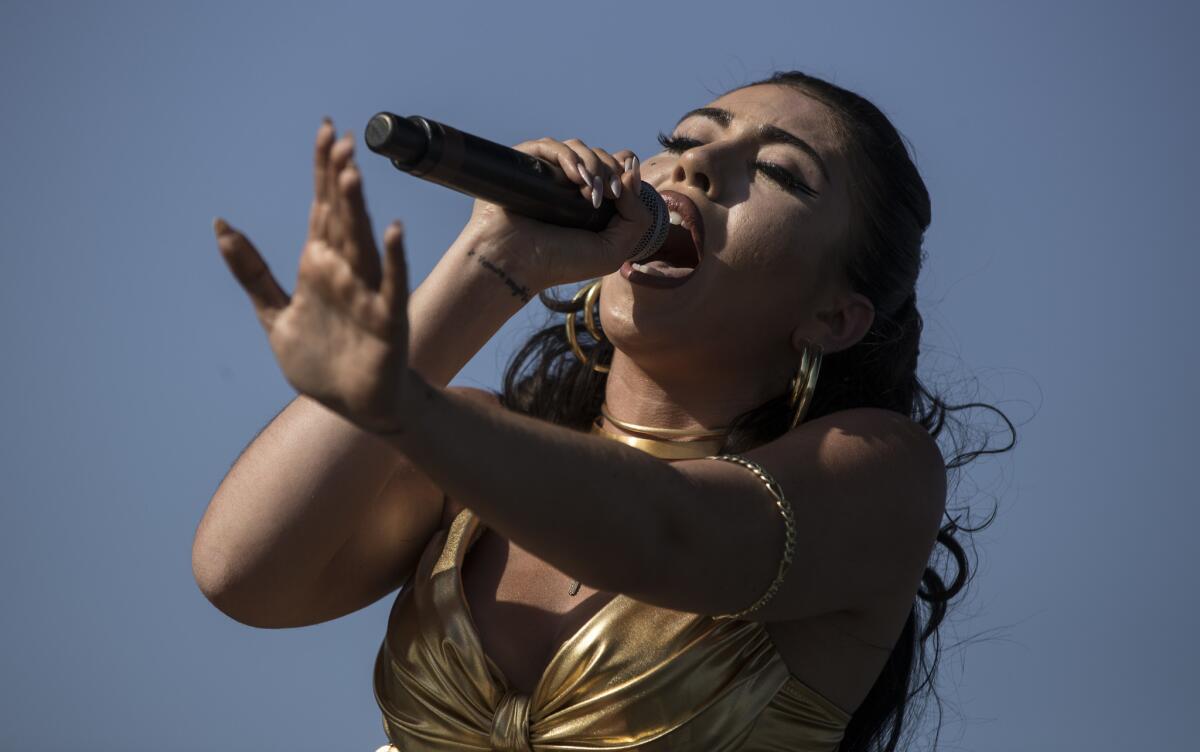
Kali Uchis’ new album is called “Isolation,” but she was anything but alone at her set at Coachella’s Outdoor Theater on Friday.
The Colombian American singer is one of the quintessential new pop voices right now, running Amy Winehouse’s melancholy soul through a contemporary sheen of dub reggae, Latin pop and hip-hop brashness, all with a very East L.A. sense of history and longing (even though she was raised in Virginia).
She’s become an adopted favorite of L.A. — her Coachella warmup set in downtown and her gig at the recent Tropicalia fest were all slammed with eager fans who knew every word in English and Spanish.
Her Friday set was no different — “In My Dreams” had a buoyant escapism and early-rock-and-roll backbeat, while “Dead To Me” was all disco sass. “Tyrant” was slower rolling, perfect driving music for the road out to the desert. And when Tyler, the Creator came out for “After the Storm,” he was still just the second-most charismatic person onstage.
It didn’t matter that the crowds were so big she was barely visible from the far end of the field. Uchis is also one of the best physical performers going today, a truly gifted dancer who commands the stage with a range of alluring, impassioned or just plain ebullient moves.
Even on a screen, you just had to watch her. She was the perfect companion for the late-afternoon desert smoulder.
A closer look at Coachella fans
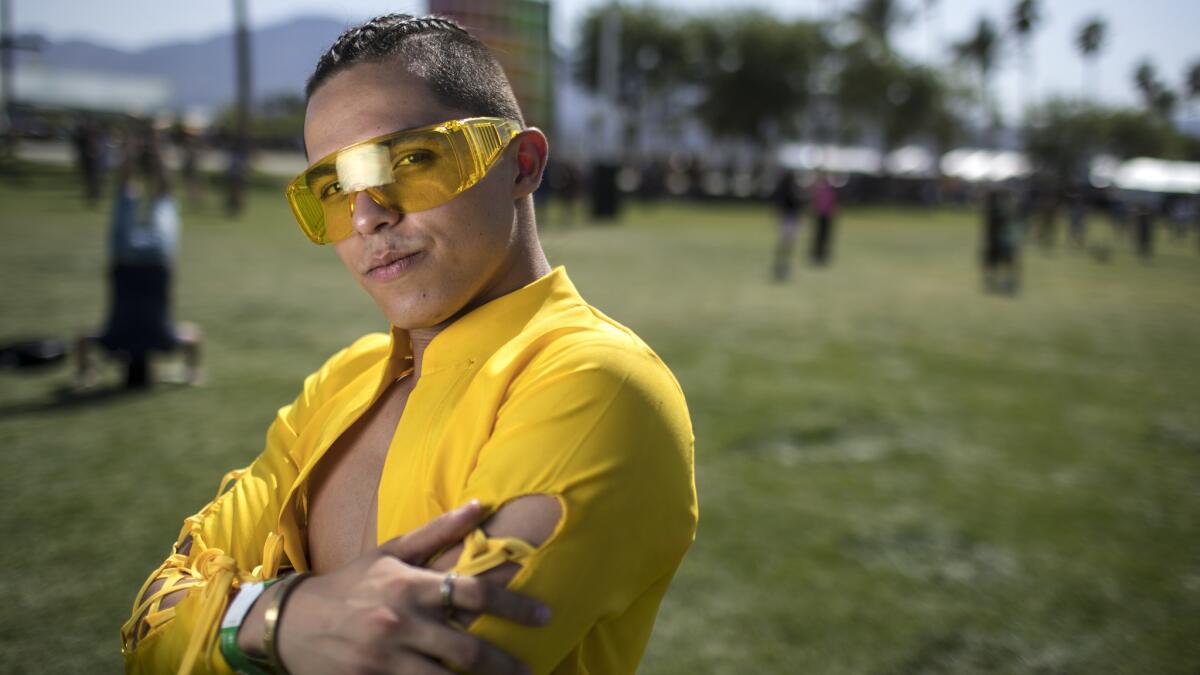
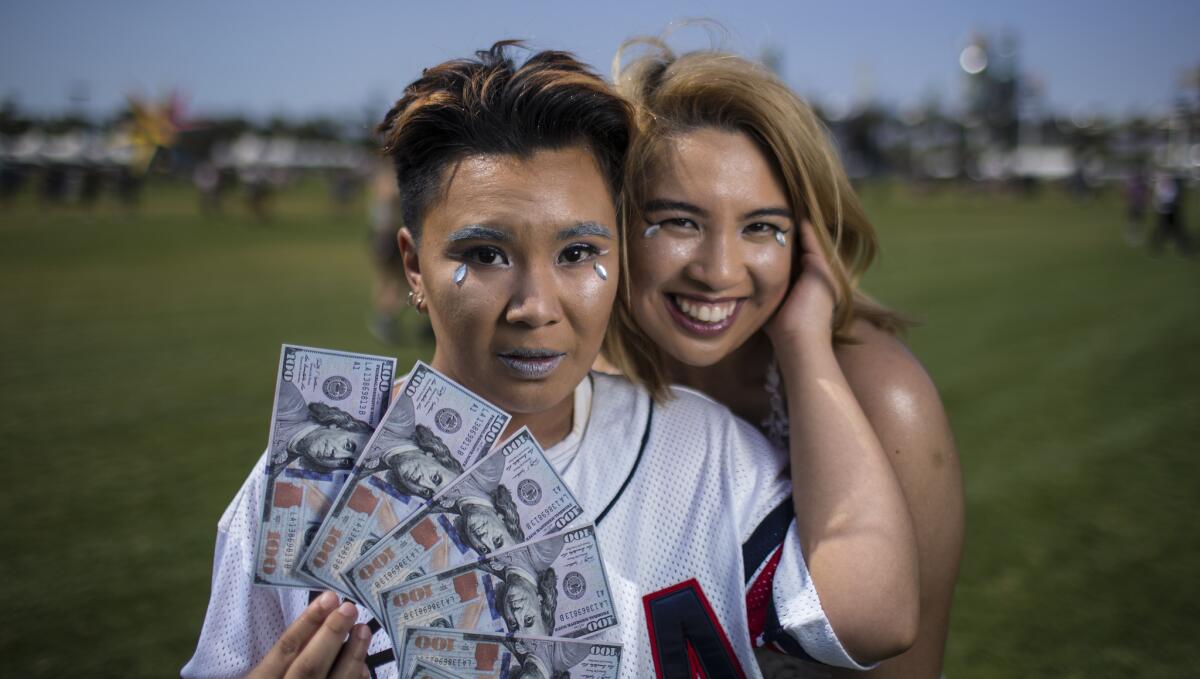
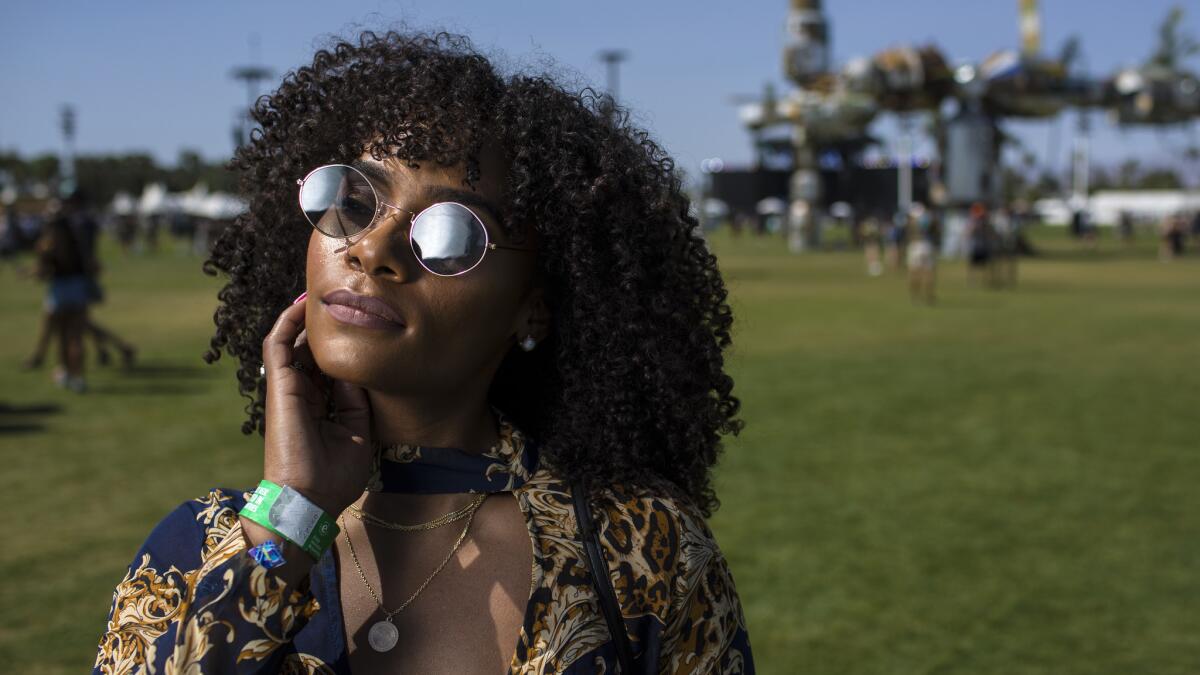
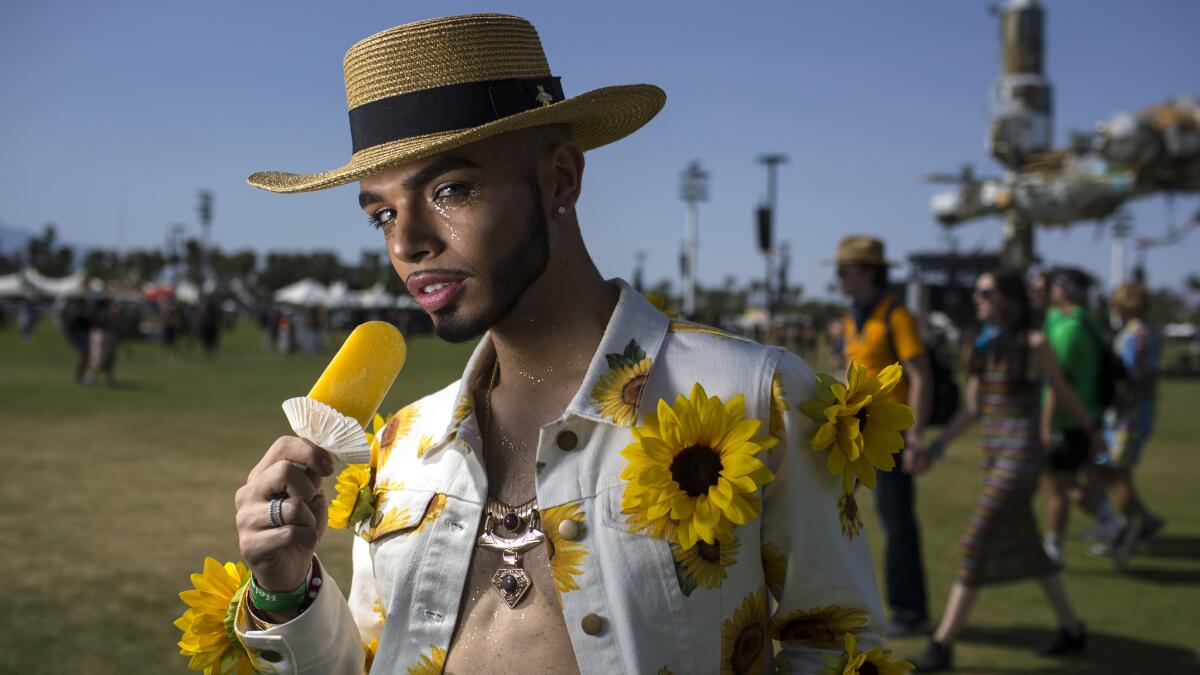
Coachella turns to drones to update the modern fireworks show
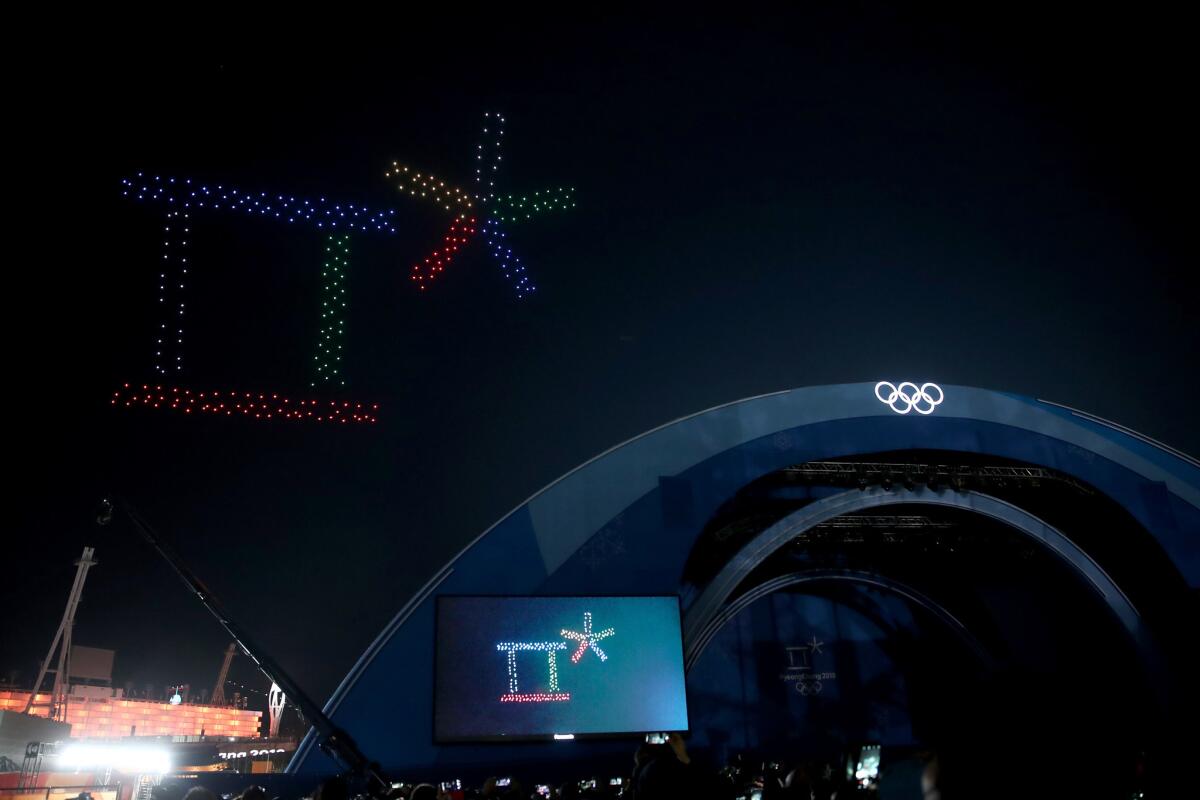
In a very 2018 update to the classic fireworks show of yore, HP and Intel will fly drones over the Coachella Valley Music & Arts Festival grounds Friday and Sunday night.
Weather permitting, the drones will fly before the Weeknd takes the stage Friday night and during Odesza’s set on Sunday, the first time a live drone show will be used during a concert.
“We’ve done multiple events worldwide,” said Anil Nanduri, vice president and general manager of Intel’s drone team. The team has been responsible for drones used during the Bellagio’s water show, the Superbowl and the winter Olympics. “Bringing this together for an artist experience has its own charm.”
Four hundred and twenty plastic and foam drones will be used to form a painting in the sky. The computer-operated, human-piloted drones are reprogrammable, rechargeable and reusable, and at 330 grams, each weighs about the same as a volleyball. The battery life sustains them for about 20 minutes, though shows usually last between five and eight minutes.
“At the Olympics it was about the sports theme and showcasing a snowboard in the sky,” said Nanduri. “The Super Bowl was about integrating it into the halftime show. With Coachella being a premier music festival has its own charm.”
Azules’ cumbia beat: A well-received first for Coachella
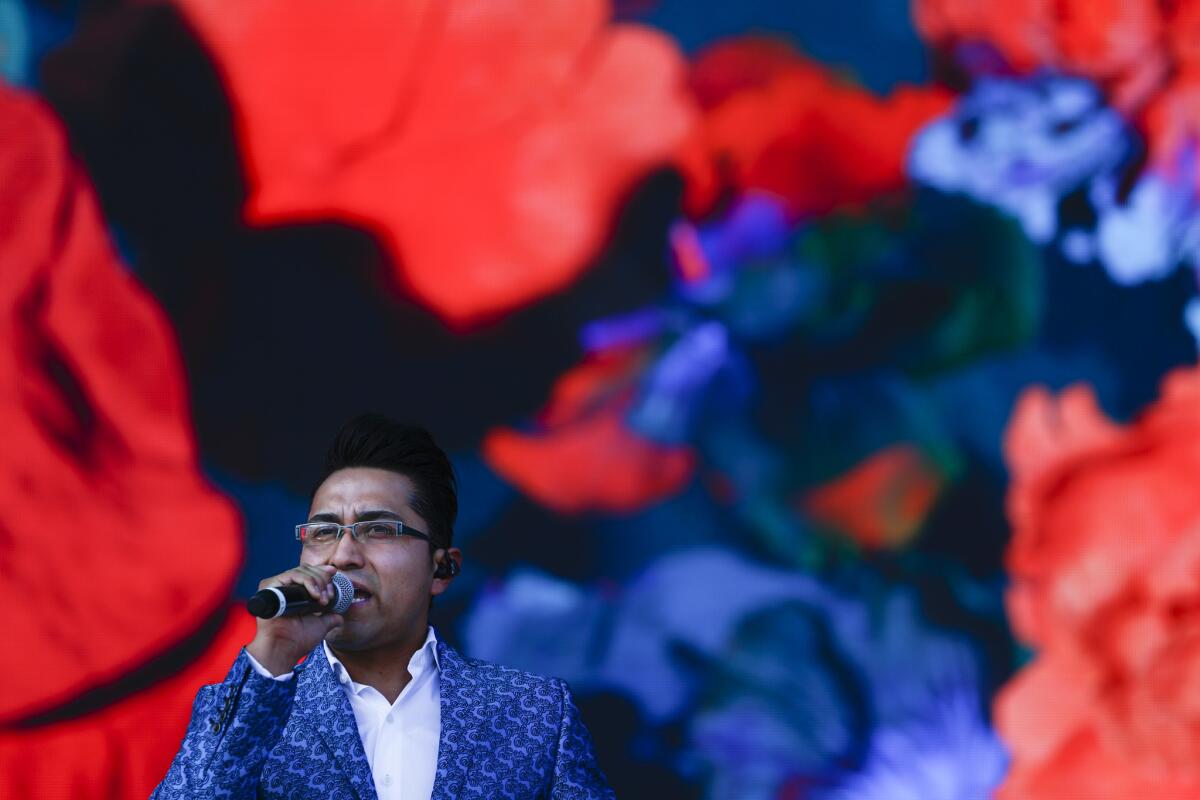
The first performance slot on Coachella’s main stage isn’t exactly a coveted position at a desert festival where many fans don’t even bother to show up until after sundown.
But Los Ángeles Azules drew a relatively gigantic crowd in that spot on Friday afternoon — perhaps because its position on the bill wasn’t its only first.
Based near Mexico City, Los Ángeles Azules was the first traditional cumbia group to play Coachella, which has boosted its share of Latin music this year with additional bookings for the likes of Kali Uchis and Cuco.
On Friday, the slick but effective dance band — with 18 musicians onstage in carefully coordinated outfits — was welcomed with an enthusiasm that suggested festival-goers had been waiting for Coachella to embrace an important aspect of Southern California’s musical landscape.
Long lines and even longer walks (oh yeah, and some decent tunes)
No one can begrudge Coachella for taking security extra seriously in the wake of last year’s shooting at the country-focused Route 91 Harvest Festival in Las Vegas. A little patience should be expected from fans as they deal with realities of a world where concerts and nightclubs have become notable targets for mass attacks.
But man, on a day this hot, you feel it when the first hour in line at your security checkpoint passes and you’ve only moved a few feet.
As the fest grows bigger every year, the challenges of safely steering this many people inside get more and more considerable.
Last year, the crowds swelled by a quarter to 125,000 daily, and this year the new layout is (in addition to being a bit of a mind-melt) already taking a bit of a physical toll.
The dance-driven Sahara Tent is right at the main entry, and a new dining hall and VIP area slices through the main concourse — separating the stages — and everything seems a bit more of a hike to find. Budget 15 to 20 minutes to trek between stages and navigate crowds, art installations and VIP pens.
That photo above of weary, sweaty Coachella general admission crowds in the entry line was taken around 1:30 p.m., and I got across the field just in time for the end of Knox Fortune’s set at 3:30 p.m.
Fortunately, a bracing blast of punk was just the tonic for a start of the day like that. The Chicago act, led by Chance the Rapper pal Kevin Rhomberg, whose stage name is Knox Fortune, boasts a range of percussion, gang vocals and pure pop sugar into its rowdy arrangements. The song “I Don’t Wanna Talk About It” was a perfect cut to close with — instantly memorable, and full of verve for the weekend to come.
It’s almost enough to make you forget the two hours you spent with your nose in some dude’s armpit on the way in.
Darren Criss, Paris Jackson and a stunt shaman decamp to the desert to celebrate Dior Sauvage Eau de Parfum
Coyote seemed to be up to his old tricks in Pioneertown on Thursday evening. The trickster of Southwestern mythology conjured up gusts of wind and a drop in temperatures that threatened to scuttle Dior Parfums’ magic hour celebration of its Sauvage Eau de Parfum men’s fragrance.
The locale — the rustic Pioneertown Motel a peyote button’s throw from Pappy & Harriet’s Pioneertown Palace a few miles northeast of Yucca Valley — was chosen only partly for its proximity to the Coachella Valley Music and Arts Festival that starts Friday in Indio, according to Dior reps of the ad campaign for the fragrance, which features Johnny Depp driving around the desert in a white convertible and burying something (we know not what) in the heat-blistered ground. It was shot in nearby Joshua Tree. (The original ad was released in support of the fragrance’s eau de toilette formulation, and the April 12 dinner was to mark the launch of the eau de parfum — if that makes scents.)
Depp wasn’t present in the flesh, but his voice could be heard narrating the newest ad for the fragrance that was being screened for guests in one of the motel’s rooms. He was also there in spirit — kind of — thanks to a low-talking shaman camped out cross-legged in another rooms, who spun tales of the coyote trickster while crushing chile peppers, pink peppercorns and sage (some of the scent notes found in the new fragrance) in a molcajete while surrounded by bottles of the Sauvage Eau de Parfum.
Newsubstance’s Spectra offers a bird’s-eye view at Coachella to rival the Ferris wheel’s
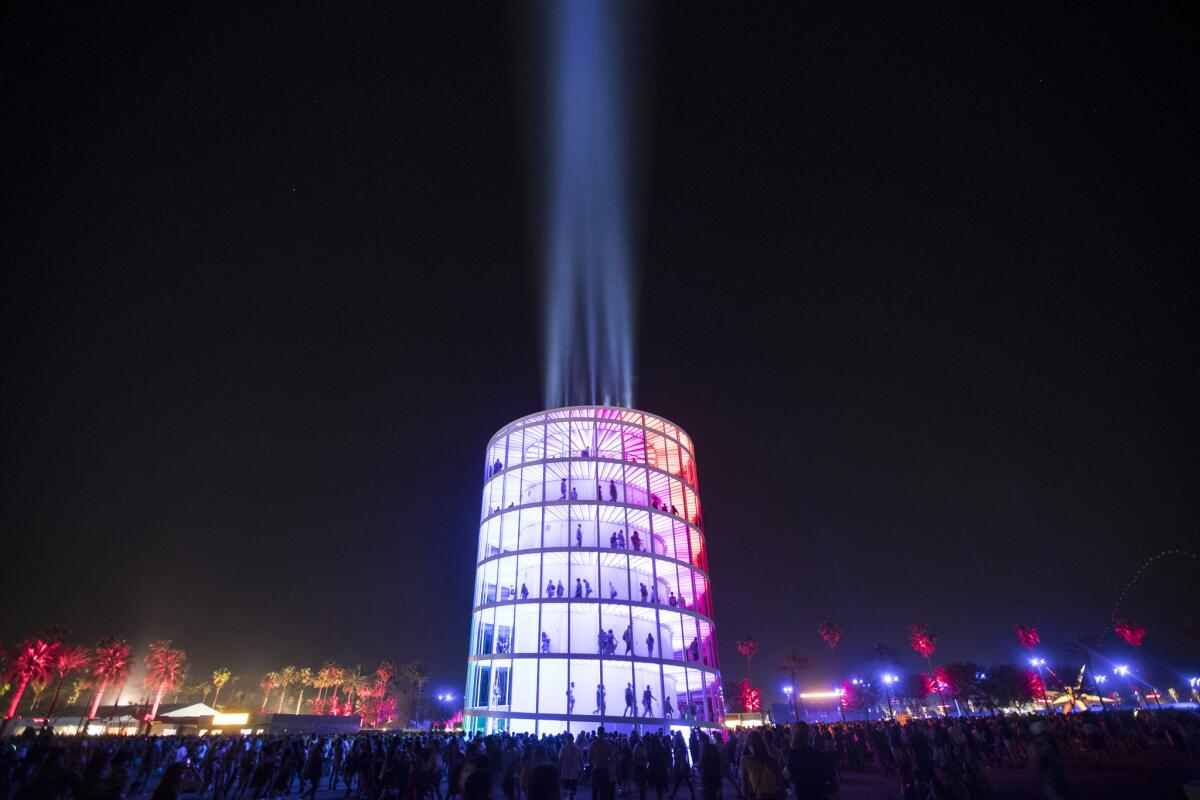
For frequent attendees of the annual Coachella Valley Music and Arts Festival, the familiar grounds can get a bit … stale.
Lucky for them, U.K.-based show design studio Newsubstance is making its debut at this year’s festival with Spectra, a multilevel, spiral-shaped pavilion that offers a fresh view of the well-known festival grounds.
“We were really keen to try to make people slow down and take a breath from the buzz of the festival,” said Patrick O’Mahony, creative director for Newsubstance. “And maybe look at the site in a totally different way.”
The seven-story structure, located in a central position on the field, offers a fresh alternative to the bird’s-eye view offered by the Ferris wheel, replete with rainbow-like waves of light and color.
“We’re in a brand-new position in terms of where art has previously gone at the festival,” O’Mahony said. “We’re almost at the center point, directly across from the main stage, so we feel like we’re almost a beacon of light at the heart of the festival.”
The journey to the top and back down again is 0.34 miles, though the observation deck at the top of the 75-foot tall structure more than makes up for the hike.
Inspired by the particular way that light washes over the Coachella Valley, Newsubstance designed Spectra to encapsulate the feeling of being engulfed by the colors of the sun. Taking its cue from the valley’s picturesque sunrises and sunsets, the structure charts through a prism of 31 colors that change with every step courtesy of a series of hidden light fixtures.
“As guys from Britain, we don’t often see the sun shine very much,” O’Mahony said. “So as you go through, you’re fully washed with those rich colors we associate with the Coachella festival.”
After festivalgoers ascend the structure (whose incline O’Mahony promises is very gradual), they will emerge onto a 360-degree terrace with a can’t-miss view of the grounds and stages below. Spectra is expected to remain a permanent fixture at Coachella for at least the next few years.
“People come to our events, and they’re in a really happy place,” O’Mahony said. “Seeing those experiences is one of the drivers in our work. It’s why the festival scene and the art scene is so interesting to us.”
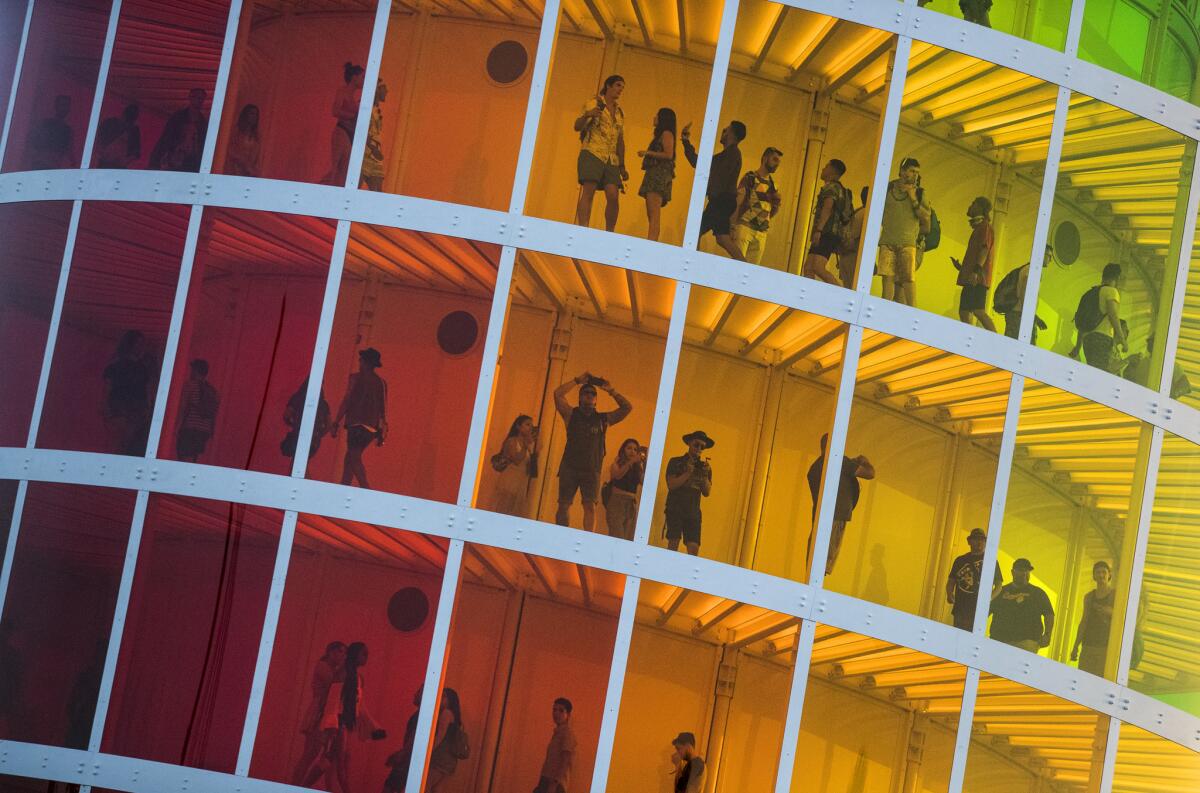
“We’re in a brand-new position in terms of where art has previously gone at the festival,” O’Mahony said. “We’re almost at the center point, directly across from the main stage, so we feel like we’re almost a beacon of light at the heart of the festival.”
The journey to the top and back down again is 0.34 miles, though the observation deck at the top of the 75-foot tall structure more than makes up for the hike.
Inspired by the particular way that light washes over the Coachella Valley, Newsubstance designed Spectra to encapsulate the feeling of being engulfed by the colors of the sun. Taking its cue from the valley’s picturesque sunrises and sunsets, the structure charts through a prism of 31 colors that change with every step courtesy of a series of hidden light fixtures.
“As guys from Britain, we don’t often see the sun shine very much,” O’Mahony said. “So as you go through, you’re fully washed with those rich colors we associate with the Coachella festival.”
After festivalgoers ascend the structure (whose incline O’Mahony promises is very gradual), they will emerge onto a 360-degree terrace with a can’t-miss view of the grounds and stages below. Spectra is expected to remain a permanent fixture at Coachella for at least the next few years.
“People come to our events, and they’re in a really happy place,” O’Mahony said. “Seeing those experiences is one of the drivers in our work. It’s why the festival scene and the art scene is so interesting to us.”
After festivalgoers ascend the structure (whose incline O’Mahony promises is very gradual), they will emerge onto a 360-degree terrace with a can’t-miss view of the grounds and stages below. Spectra is expected to remain a permanent fixture at Coachella for at least the next few years.
“People come to our events, and they’re in a really happy place,” O’Mahony said. “Seeing those experiences is one of the drivers in our work. It’s why the festival scene and the art scene is so interesting to us.”
The Regrettes bring a timely message — and a timeless sound — to Coachella
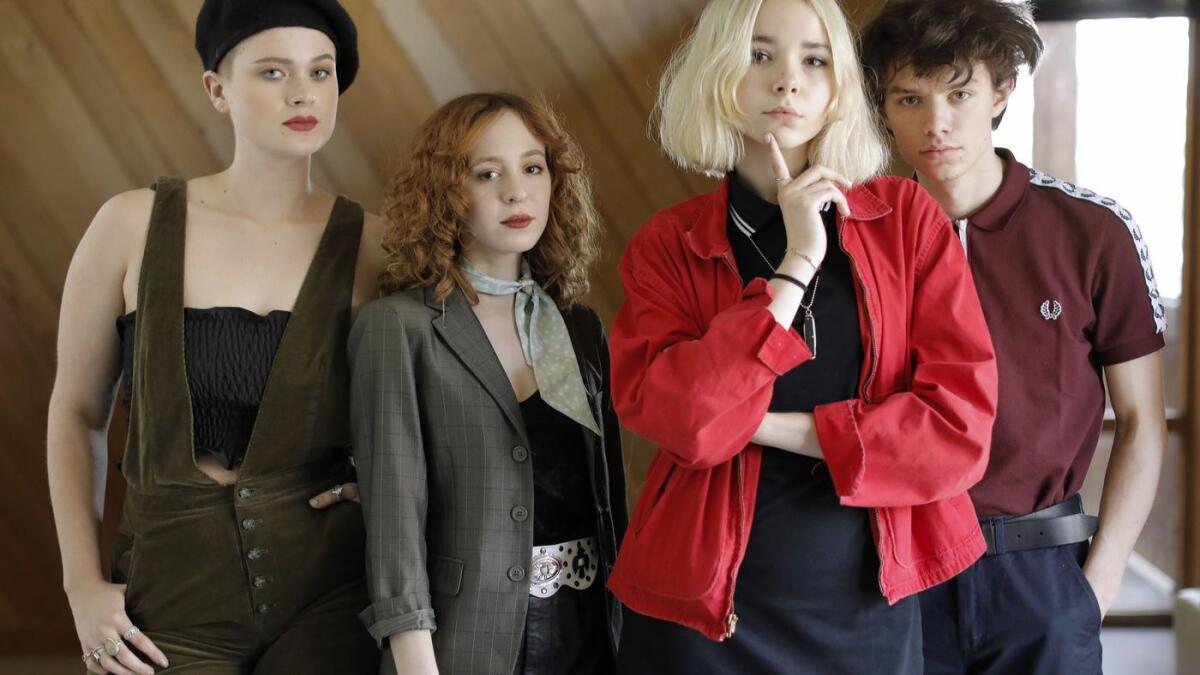
When the spirited, local punk-leaning pop band the Regrettes last played a major Southern California festival, things didn’t go as planned. Performing at a multiday event last fall in San Pedro, the band’s teenage lead singer, Lydia Night, was attacked mid-performance by a woman in a superhero costume who managed to work her way onto the stage.
“Someone invaded my safe space in an aggressive manner and that is absolutely not OK,” Night wrote on Instagram after the incident. It’s believed by the band that the woman mistook Night for someone else and that she had been incorrectly led to believe Night had come between her and her boyfriend.
Last month, in the offices of her label, Warner Bros. Records, Night reflected on the act of aggression and how it affected her thinking about her vulnerability onstage. She also noted that she was still surprised how it all went down, almost dumbfounded that the whole thing was a case of mistaken identity and not something reflective of today’s divisive political climate.
After all, the leader of the Regrettes, after just one album, already has a reputation for speaking her mind — online, in interviews and in song — about social and political issues. For instance, the band’s video for “Seashore,” a snappily vindictive anthem against everyday, casual sexism, took aim at President Trump, and Night knows such opinions could make her a target.
“That’s what’s so crazy about it,” Night said of the festivalgoer who shoved her at last October’s Growlers Six. “It wasn’t some crazy Trump supporter who was like, ‘... you for being a liberal.’ It was this chick dressed as Robin who thought I was this girl who her boyfriend had” slept with.
While a relatively small band by Coachella standards, the Regrettes have been on something of an accelerated track.
Mexico’s Los Ángeles Azules aims to set Coachella fans dancing to cumbia
Over the last 35 years, Mexico’s Los ÁngelesAzules has become one of the country’s top-selling bands using something of a radical strategy: introducing new generations to cumbia, the style of dance music considered as unhip in some corners of the Spanish-speaking world as the polka is here in the U.S.
The group in recent years has added yet another twist to a genre that younger audiences often dismissed as the antiquated music of their parents and grandparents: a hybrid called “cumbia sinfónica” that combines the compelling bounce of cumbia with the expansive sonic possibilities of a symphony orchestra, exemplified in the group’s latest album, “De Plaza en Plaza.”
“It is a grand experiment,” said lead singer and spokesman Erik De la Pena, who joined the six Avante Mejia siblings — Alfredo, Cristina, Elias, Guadalupe, Pepe and Jorge — 18 years ago.
He spoke earlier this month through a translator during an interview from the band’s home in Iztapalapa, Mexico — a borough a few miles south of Mexico City — on a rare break from a typically intensive schedule of shows across Mexico, Central and South America. That itinerary also includes the band’s debut performance later this month at the Goldenvoice-presented Coachella Valley Music and Arts Festival.
Behind its laid-back image, Coachella aggressively protects its trademark
What do Whole Foods and Sean “Diddy” Combs have in common? They both recently learned not to mess with the suffix “chella.”
A few weeks before this year’s Coachella Valley Music and Arts Festival in Indio, the Palm Desert Whole Foods announced an upcoming concert and tasting event that it dubbed Wholechella.
Soon after, the store had heard from festival lawyers. “We had to change the name,” said Christy Jeziorski, the Palm Desert location’s marketing manager. They went with the Pre-Fest Beer Garden.
Not long after, rapper and entrepreneur Combs was forced to change the name of his upcoming Bermuda Dunes bash. Originally dubbed “Combschella,” it will now be known as Combs Fest.
Like rap festival Hoodchella and movie festival Filmchella before them, Wholechella and Combschella found themselves the focus of attorneys who handle the powerful and particular trademark enforcement of festival promoter Goldenvoice, which owns the rights to the use of the word Coachella.
You could call them Lawyachella, but then you’d hear from them yourself.
The legal actions are in stark contrast to the laid-back marketing messages Coachella conveys. “The live-music experience — it’s tribal. It’s communal,” DJ Jason Bentley says in one Coachella promo, painting the festival as an oasis of freedom that supports carefree, youthful rebellion.
Portugal. The Man is a rock band with a pop hit at Coachella
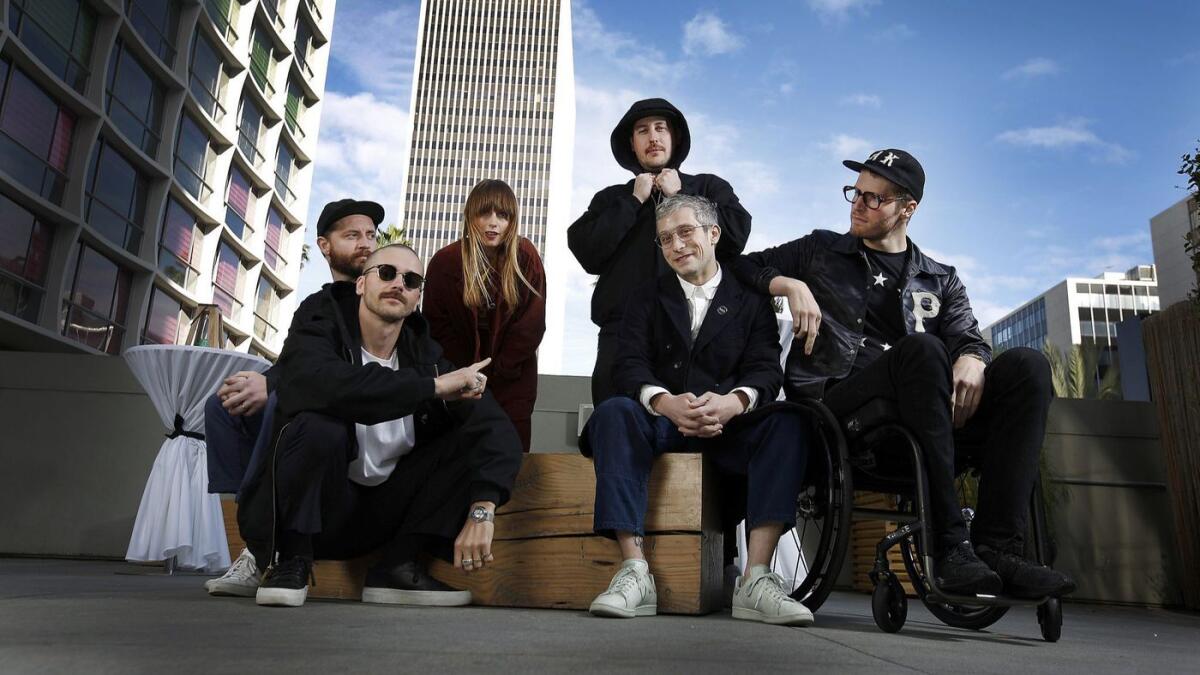
The members of Portugal. The Man have made a habit of representing rock in spaces dominated by pop and hip-hop.
Last year, their song “Feel It Still” — a maddeningly catchy number about being “a rebel just for kicks” — peaked at No. 4 on Billboard’s Hot 100 behind rap hits by Post Malone and Cardi B. In January, “Feel It Still” beat “Despacito” and a Chainsmokers track to win a Grammy Award for best pop duo/group performance.
And then there was the band’s recent gig on “Dick Clark’s New Year’s Rockin’ Eve” amid the smiling likes of Mariah Carey and Camila Cabello.
“I remember the show people said, ‘Can you be really outgoing?’” bassist Zach Carothers recalled the other day with a laugh. “I was like, ‘This is as excited as I can look — I’ve never looked more excited than this.’”
Experiential events, posh yurts and uber-VIP — will Coachella stand for anything more than its escapism this year?
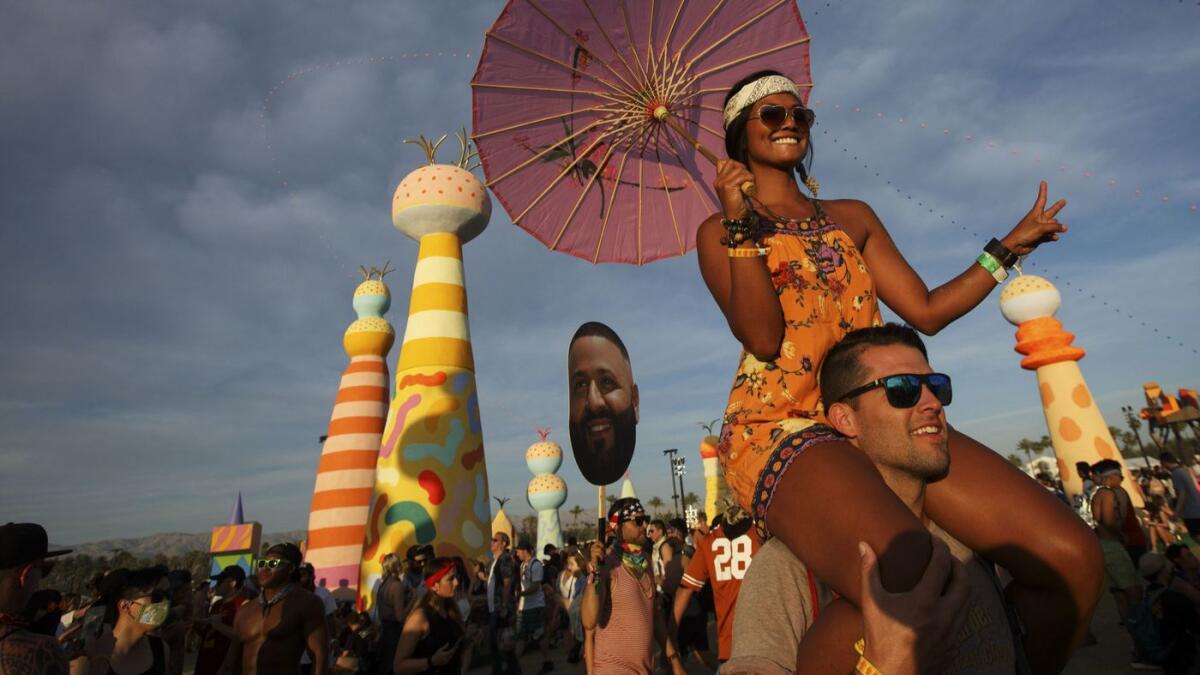
Music festivals rarely last long enough to navigate generational shifts.
But the Coachella Valley Music and Arts Festival, which launches its 19th installment on Friday and runs over the next two weekends at Indio’s Empire Polo Club, has more or less pulled it off.
Promoters have widened its music offerings to better grapple with social issues such as lineup representation and have also had to learn to navigate logistical headaches such as harassment and substance abuse. In turn, Coachella has transitioned from a scrappy Gen X rock outing to a perpetually sold-out fixture of late-millennial life in SoCal.
Or, at least, for a certain well-heeled portion of it.
“It was surprising to see just how luxurious of an experience Coachella was the first time I went,” said Jennifer Utz Ilecki, Marriott International’s vice president of buzz marketing and global partnerships. “The quality of food, the high-end experiences. People are willing to spend a lot of money on that. For a lot of people, Coachella becomes a great, Instagrammable vacation.”
Heading to Coachella? Forget about the flower crowns. Try these fashion picks on for size
Leave the flower crowns and fringe at home this time around. Music festival dressing really is about color selections, creativity and looking effortlessly thrown-together with the right amount of style.
The must-haves? Pack sexy tops, a hands-free carryall bag, sparkling nail colors and the requisite floaty robe to be worn over denim cutoffs along with a great pair of booties, a stylish hat and multipurpose jewelry.
That’s just for starters. Also, you’ll want to have statement shades, distressed denims and a short-sleeve shirt in a fun print. Just remember this: If you’re going to Coachella, Beyoncé’s fans come dressed to impress no matter the venue. So may the fashion forces be with you.